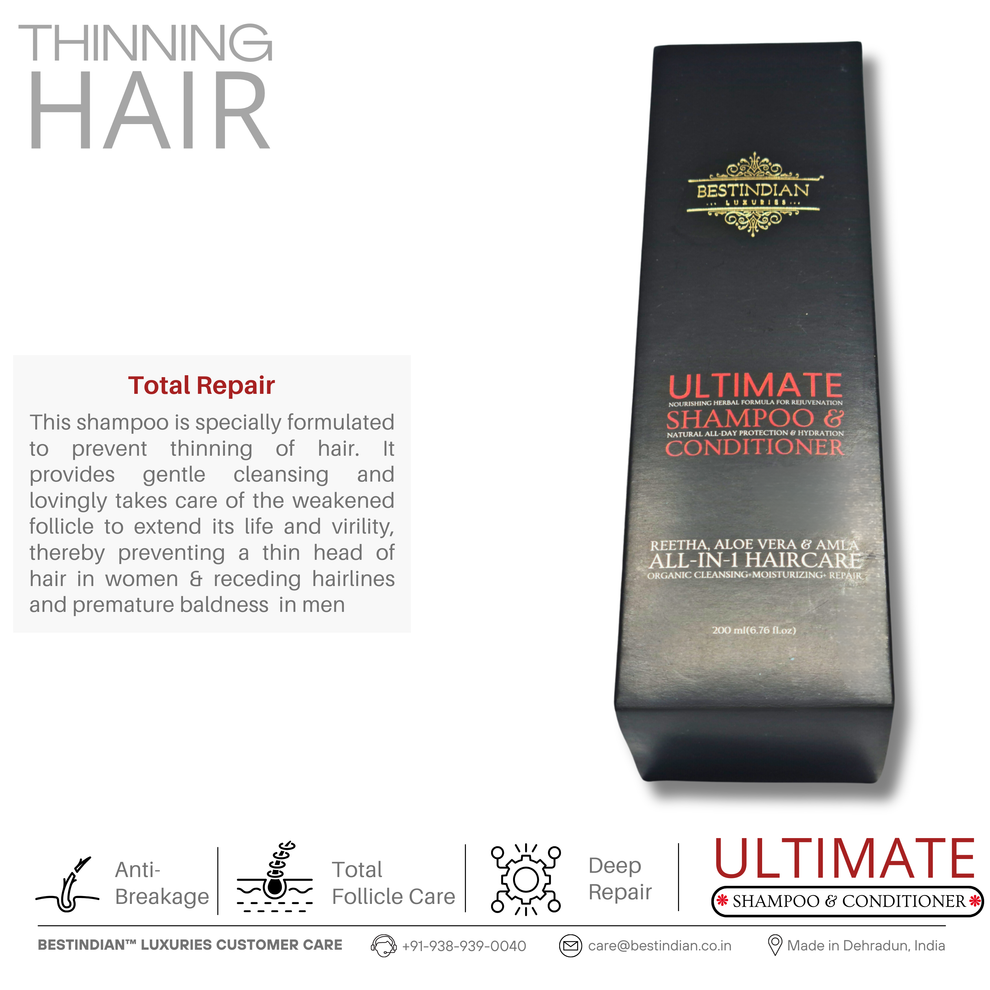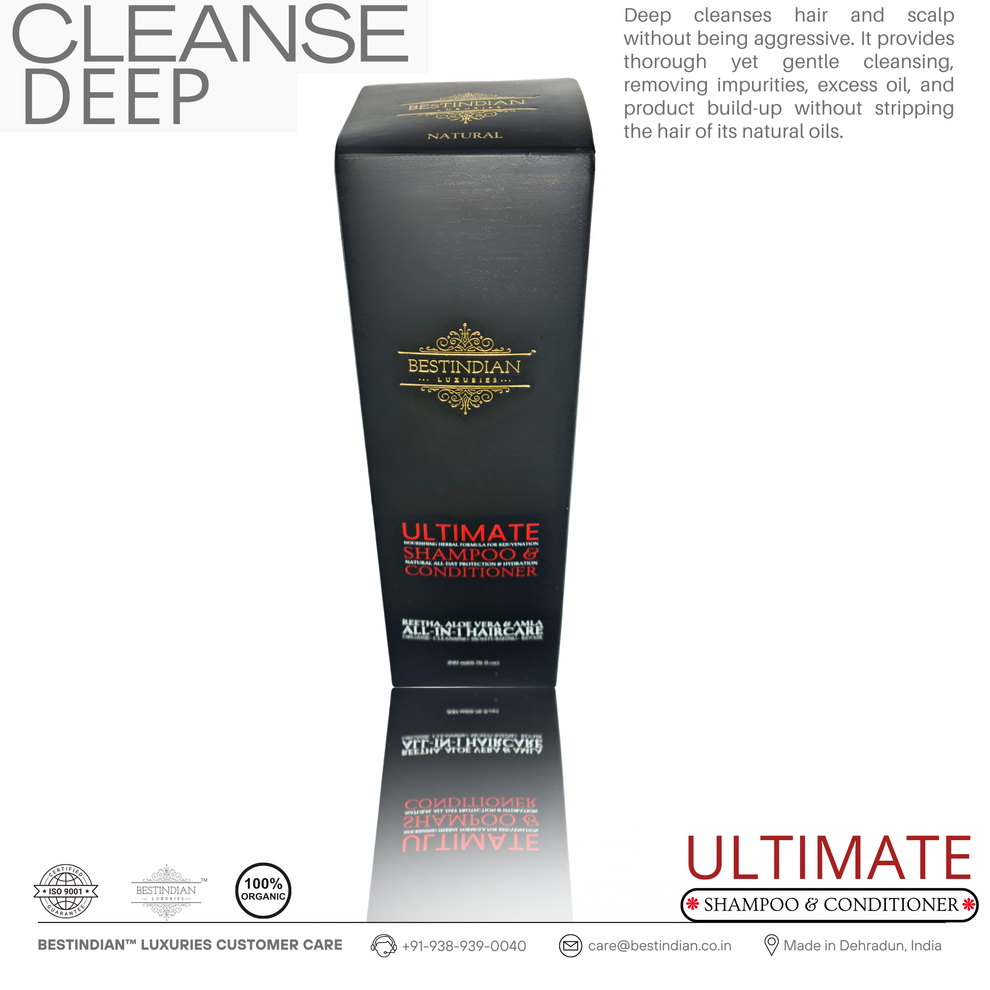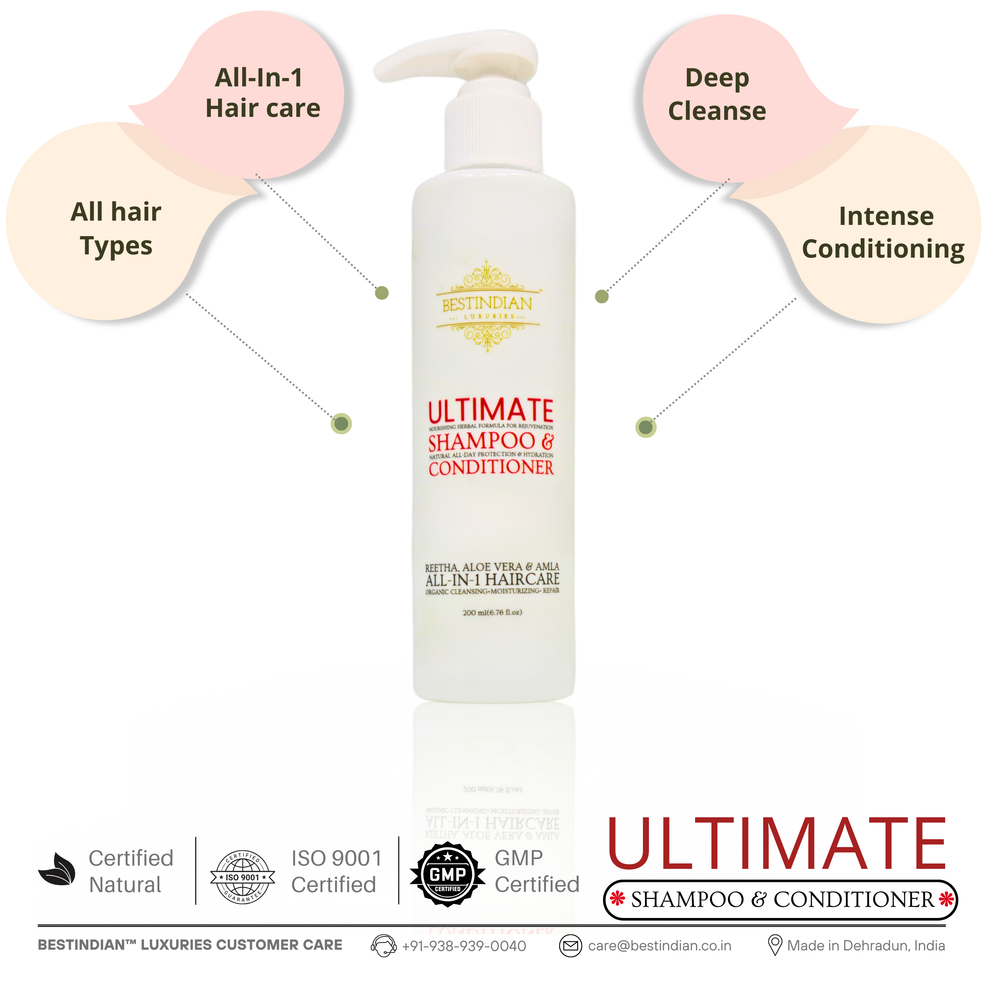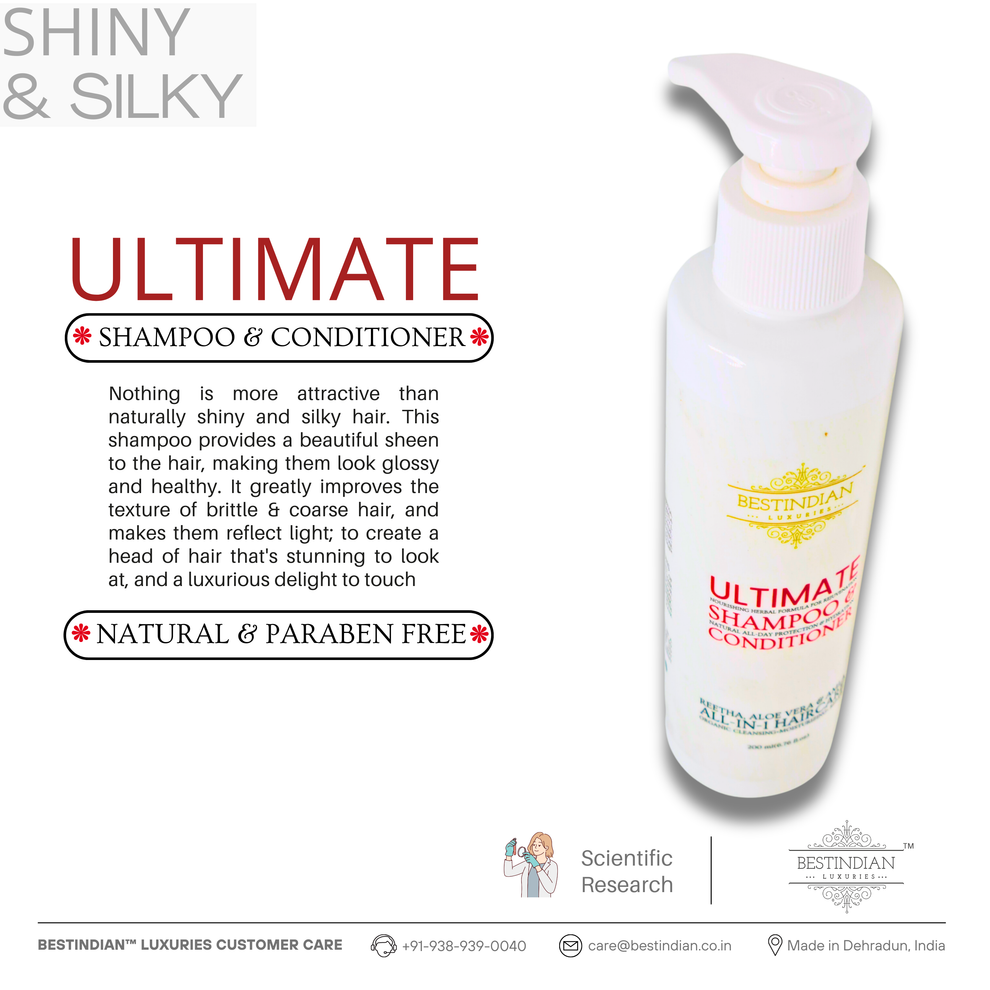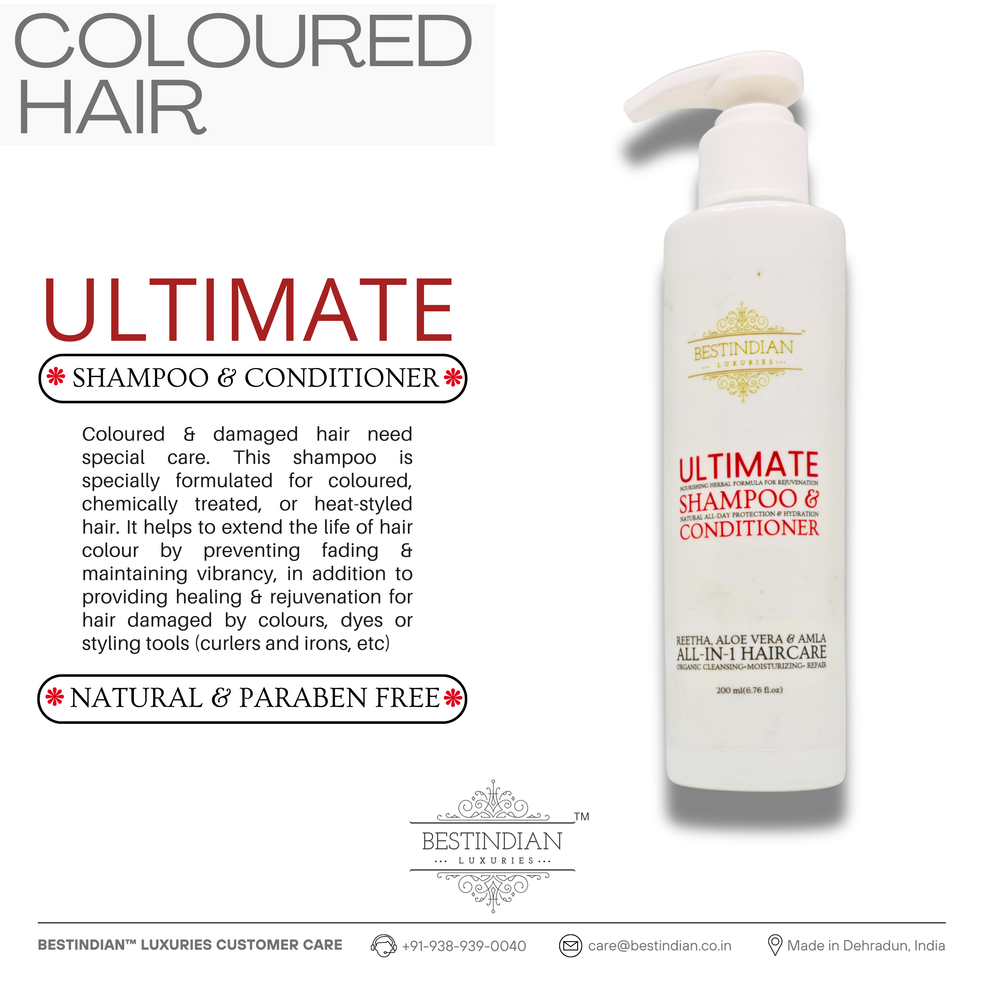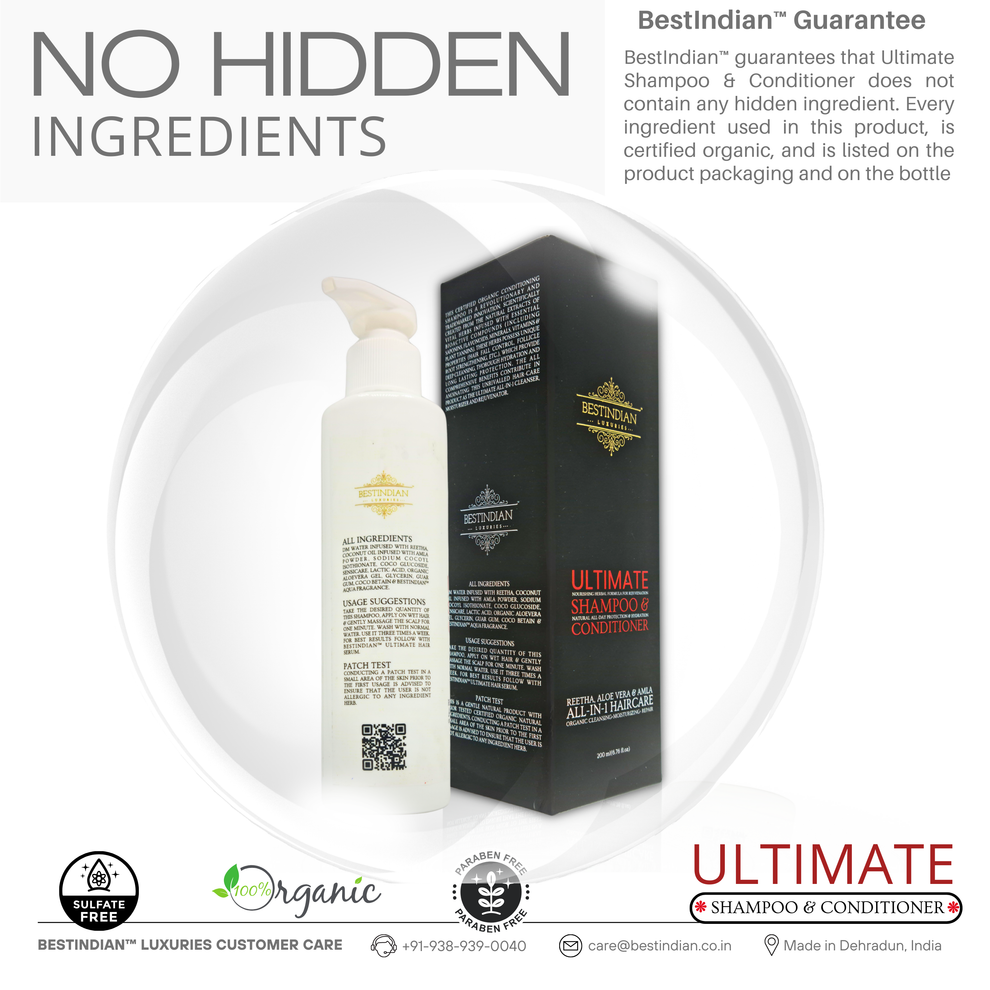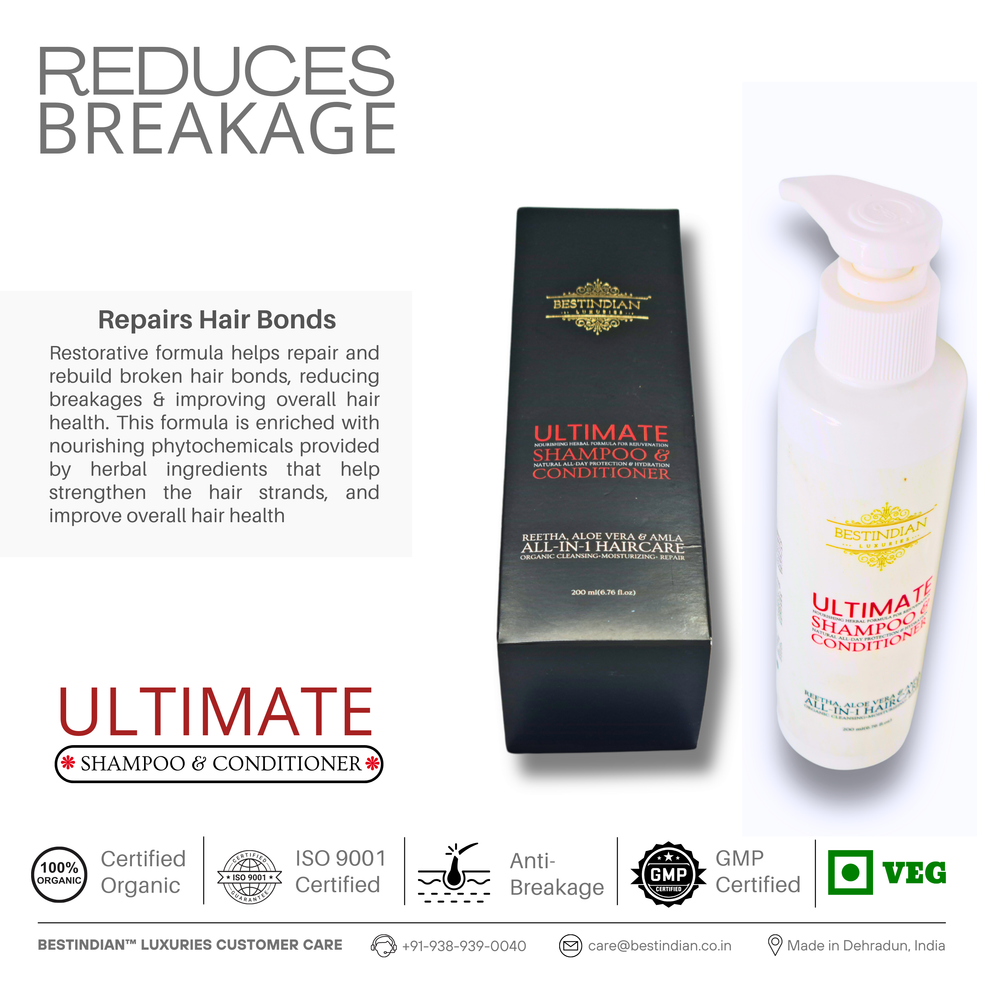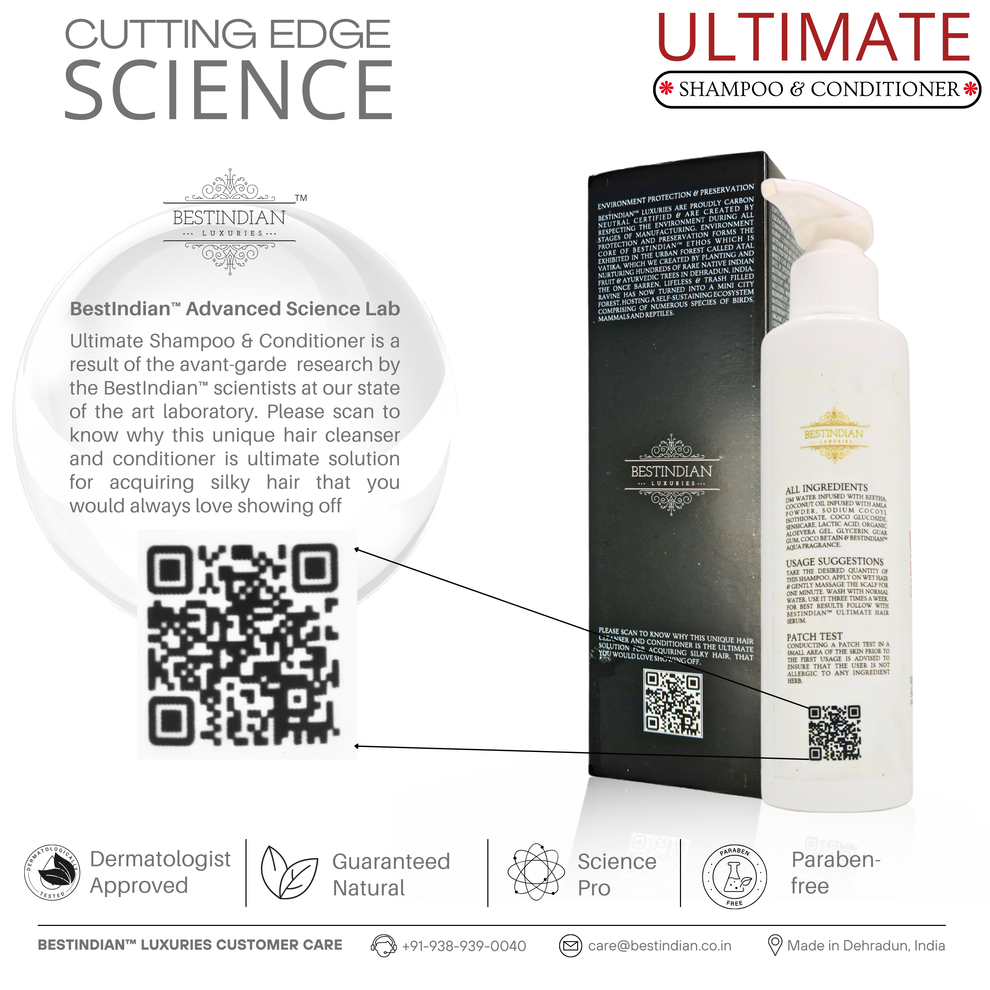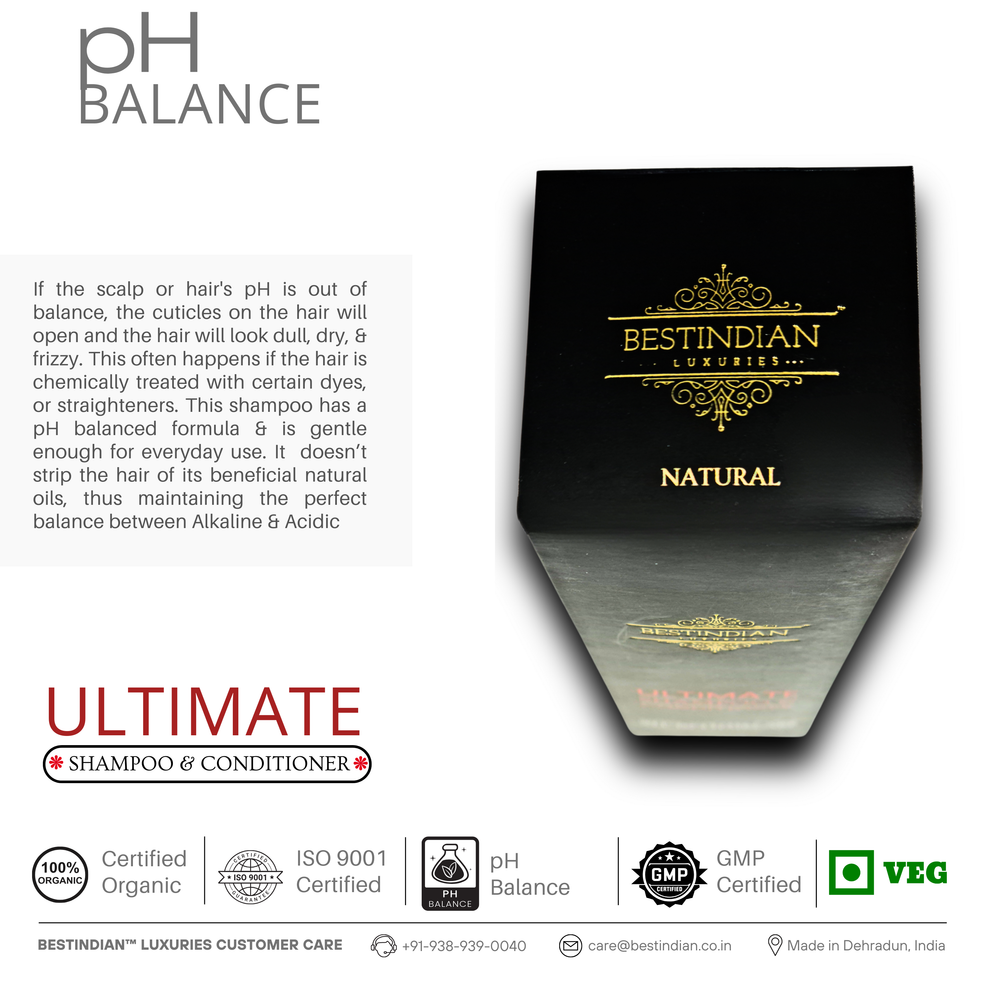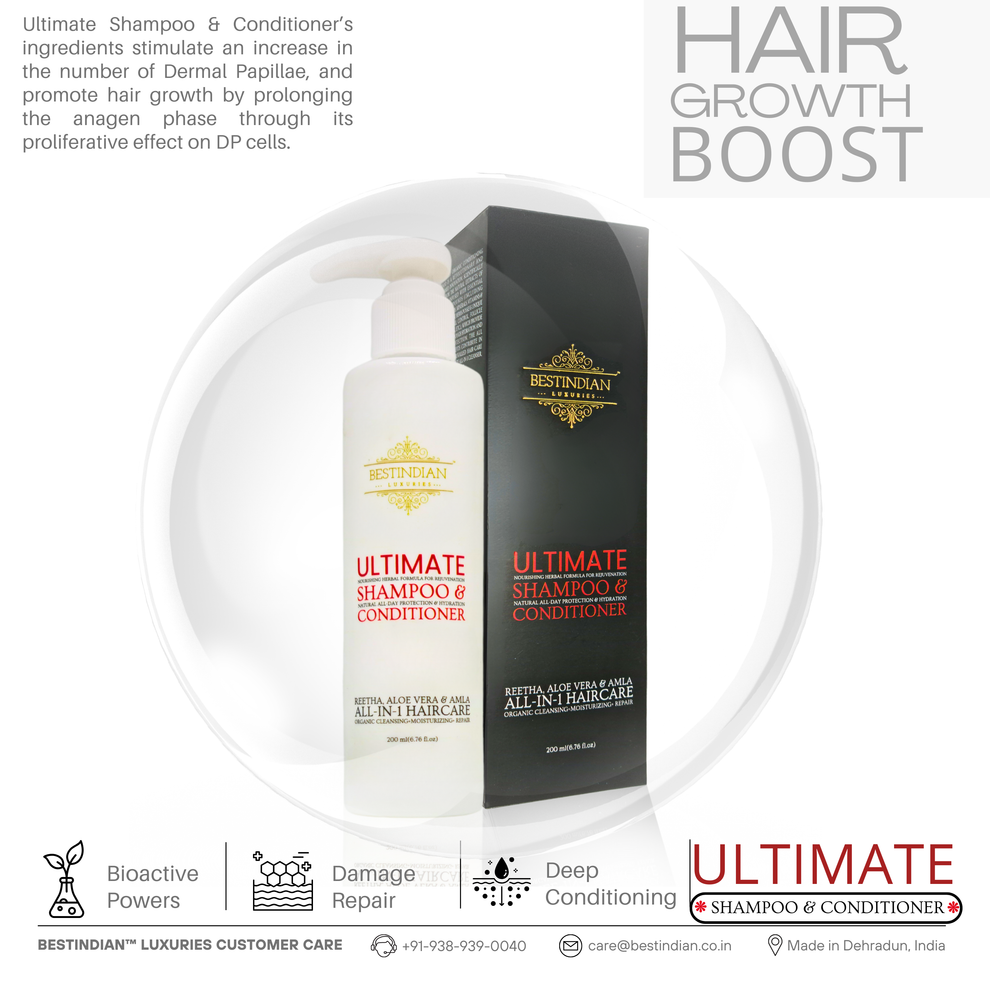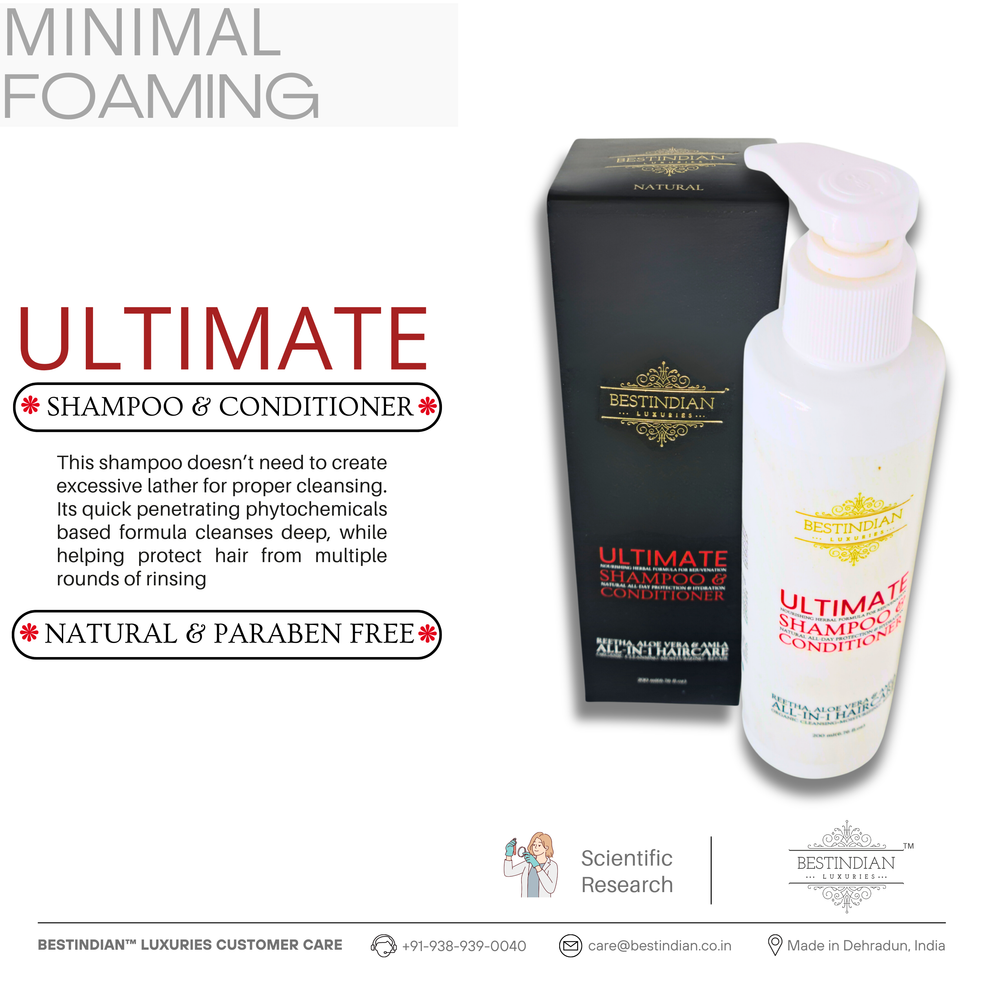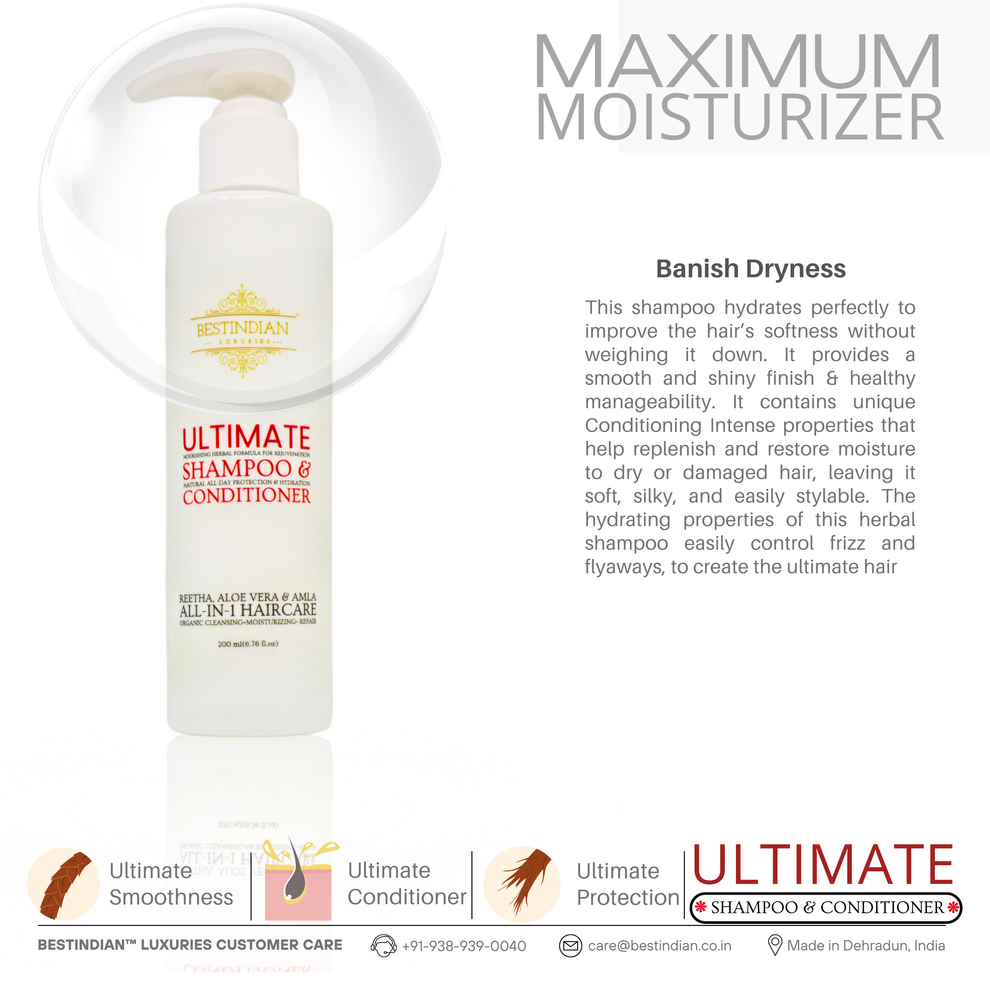BestIndian
BestIndian™ Ultimate Shampoo & Conditioner (Sulfate-Free): The Best Indian Shampoo for Hair Fall & Dandruff
BestIndian™ Ultimate Shampoo & Conditioner (Sulfate-Free): The Best Indian Shampoo for Hair Fall & Dandruff
Couldn't load pickup availability
Discover the ultimate Ayurvedic solution to scalp health and resilient hair. Our Ultimate Shampoo is a potent hair fall control shampoo, meticulously formulated to do more than just cleanse. This natural, sulfate-free shampoo, powered by Ayurvedic powerhouses like Amla and Reetha, purifies the scalp, strengthens roots, and creates the ideal foundation for healthy hair growth. Experience the difference of a truly balanced, nourishing cleanse and achieve hair that radiates health from its very foundation.
An Ayurvedic, sulfate-free shampoo for hair fall control and dandruff that strengthens roots and restores a healthy, balanced scalp.
Sulfate-Free • pH Balanced • Organic Certified Ingredients • For All Hair Types
Please Note: Conscious Archive Item (60% Off)
- Manufacturing Date: January 2024
- Best Before: January 2026
- This item is part of our Conscious Archive Sale and is offered at an exceptional 60% discount due to its approaching best before date. It is final sale.

Share
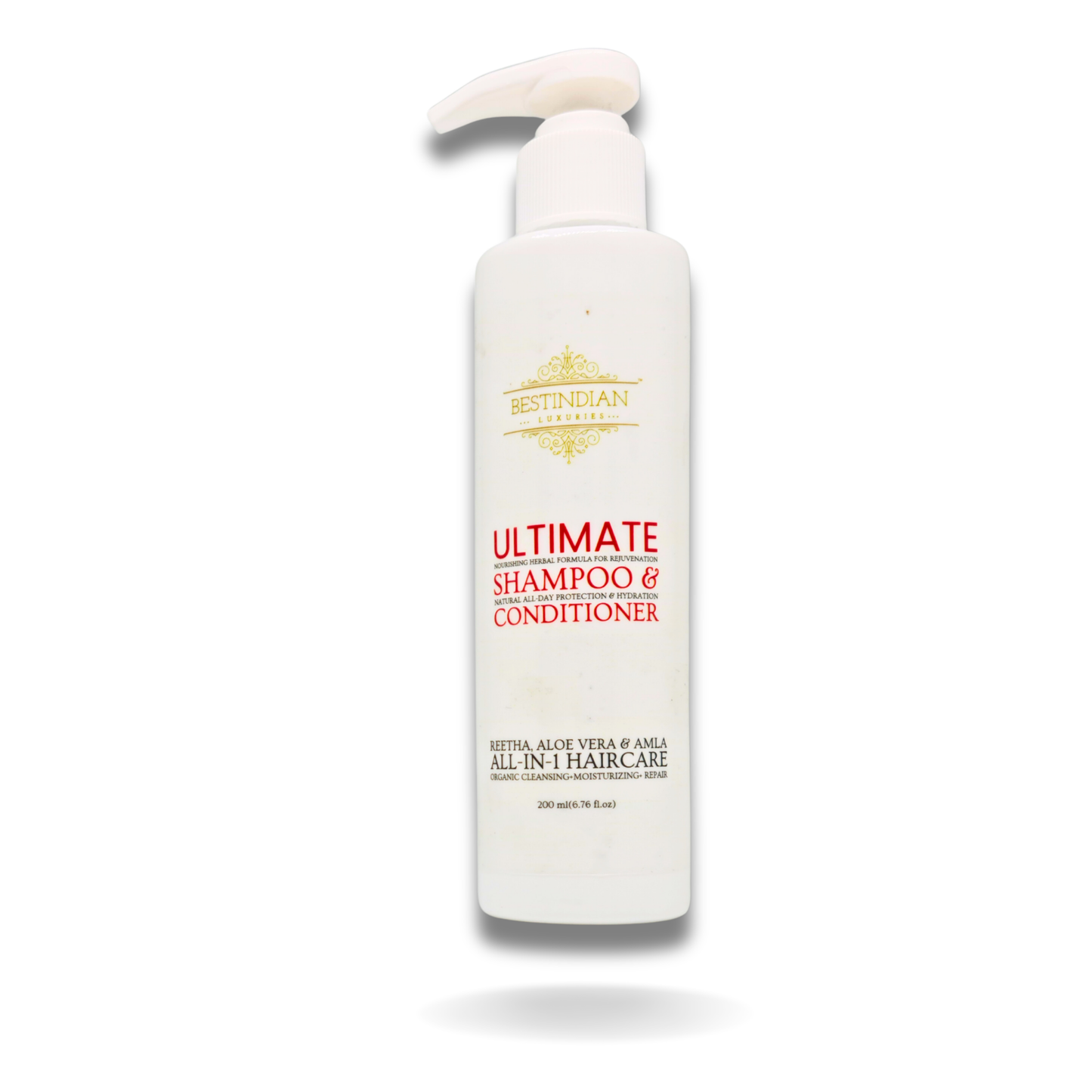
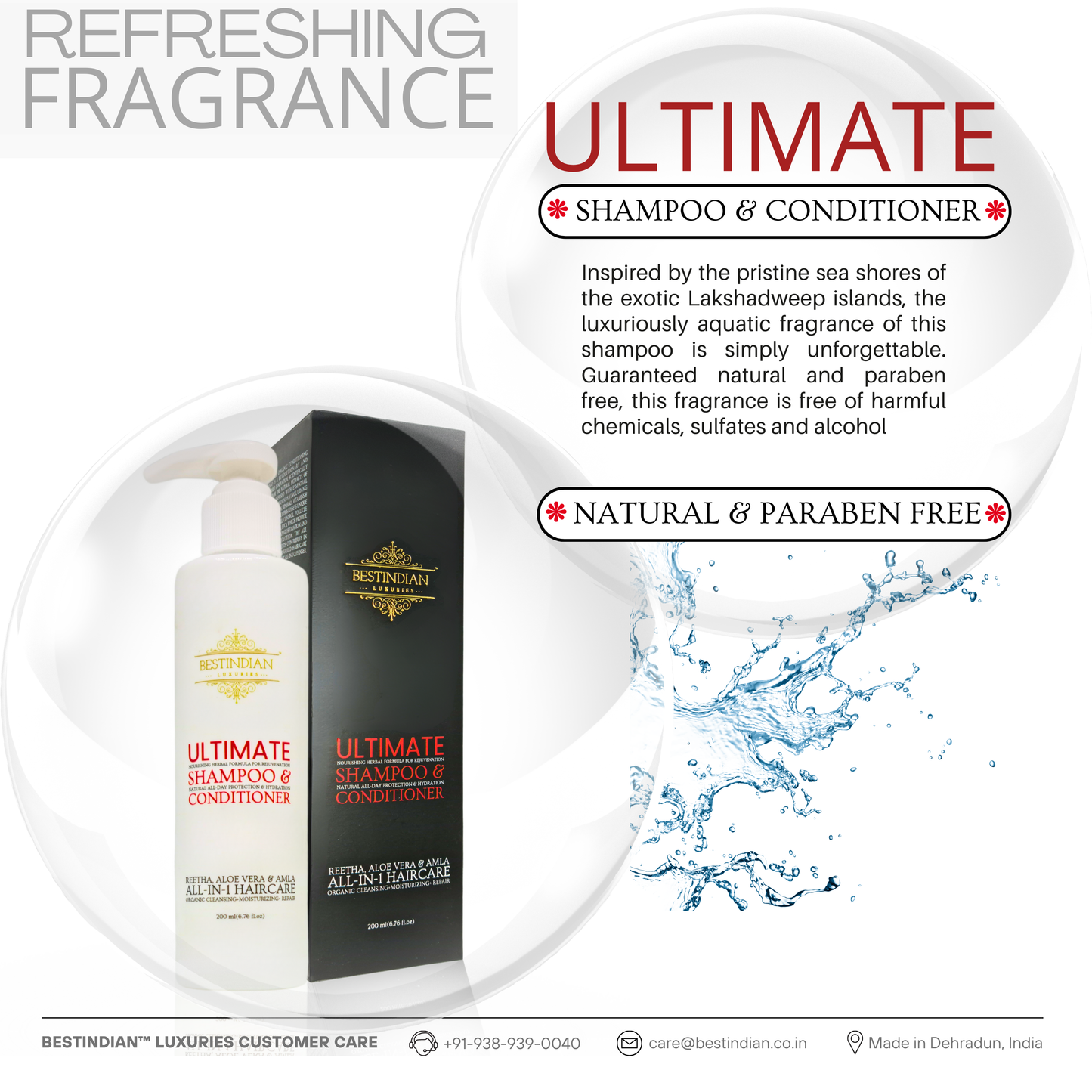


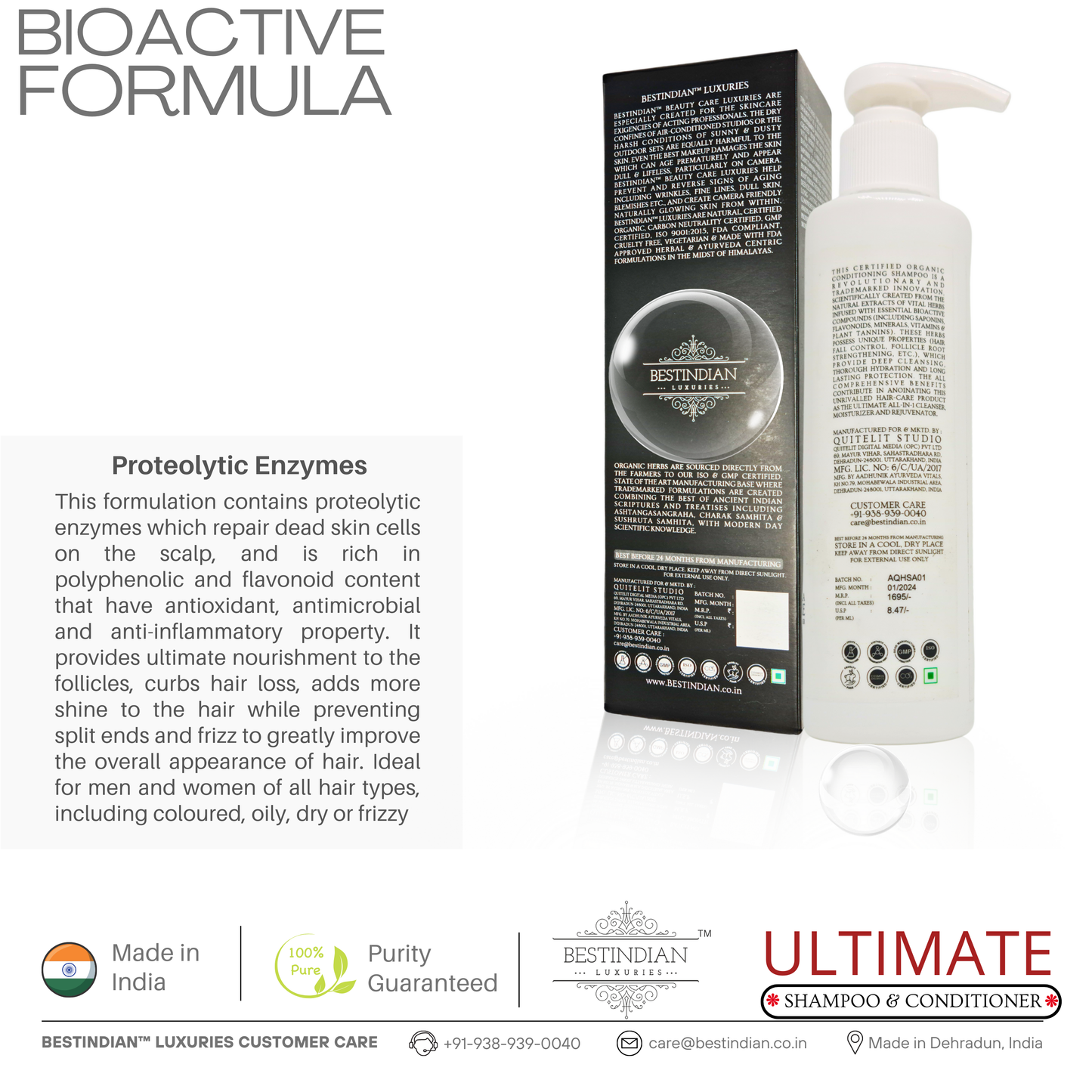
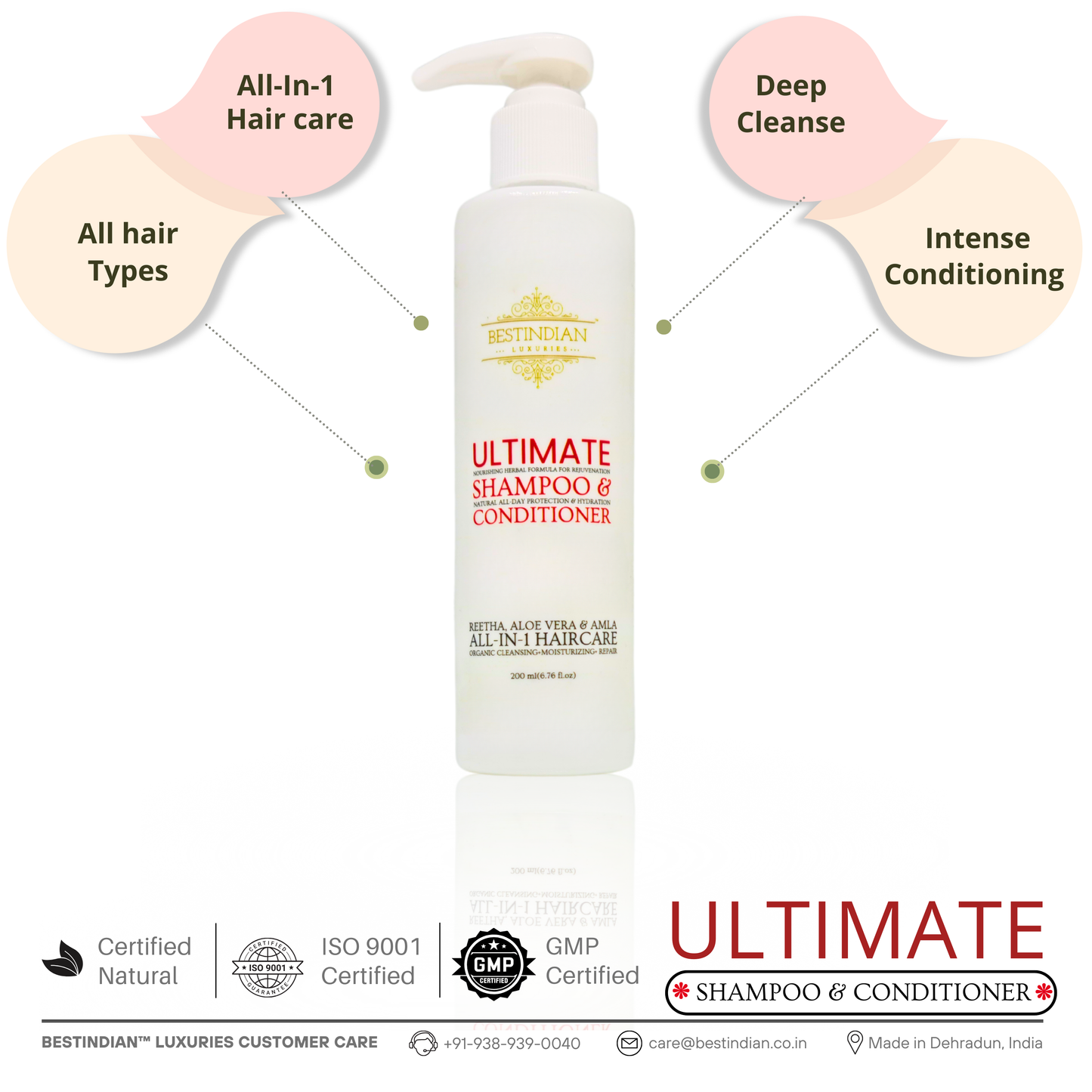
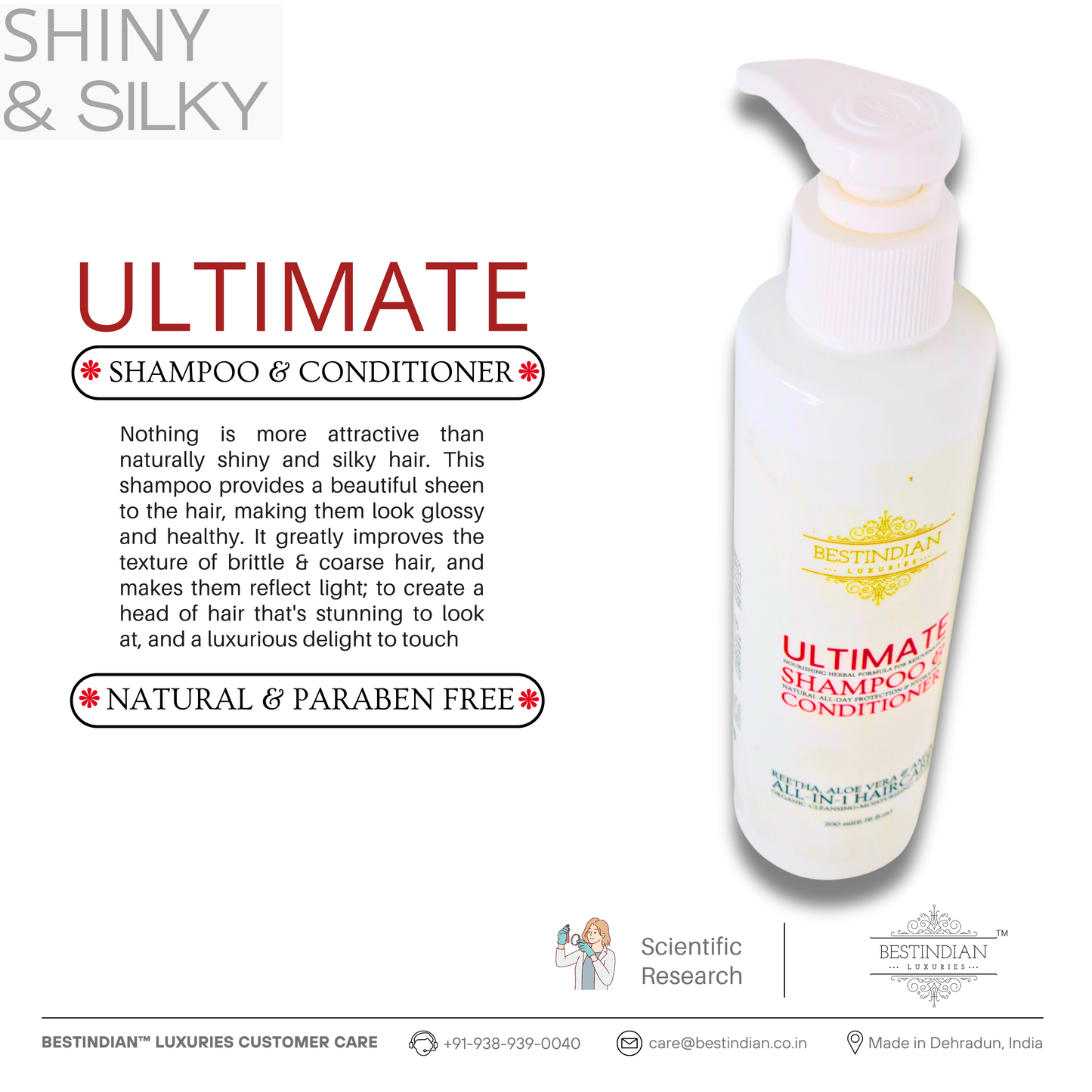
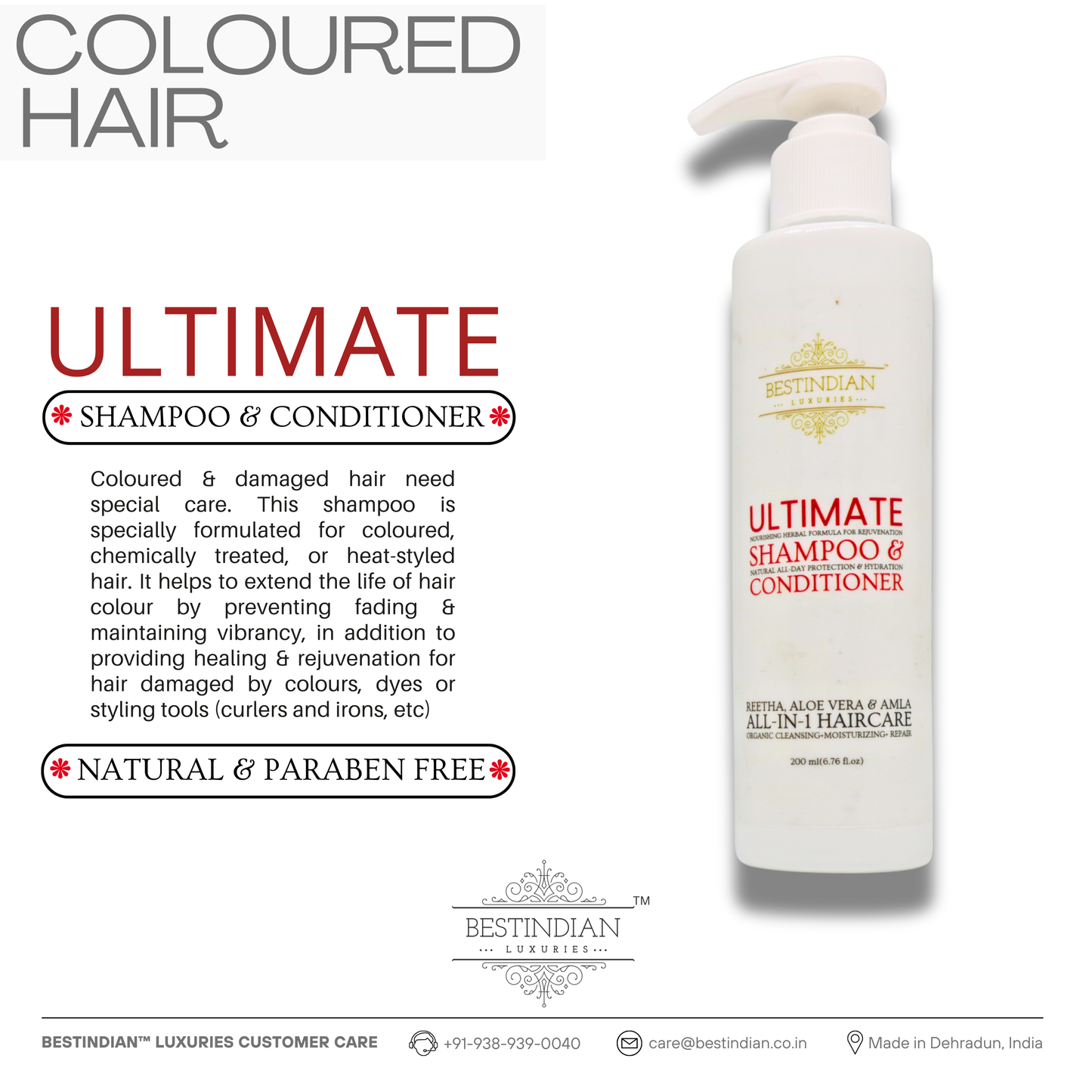
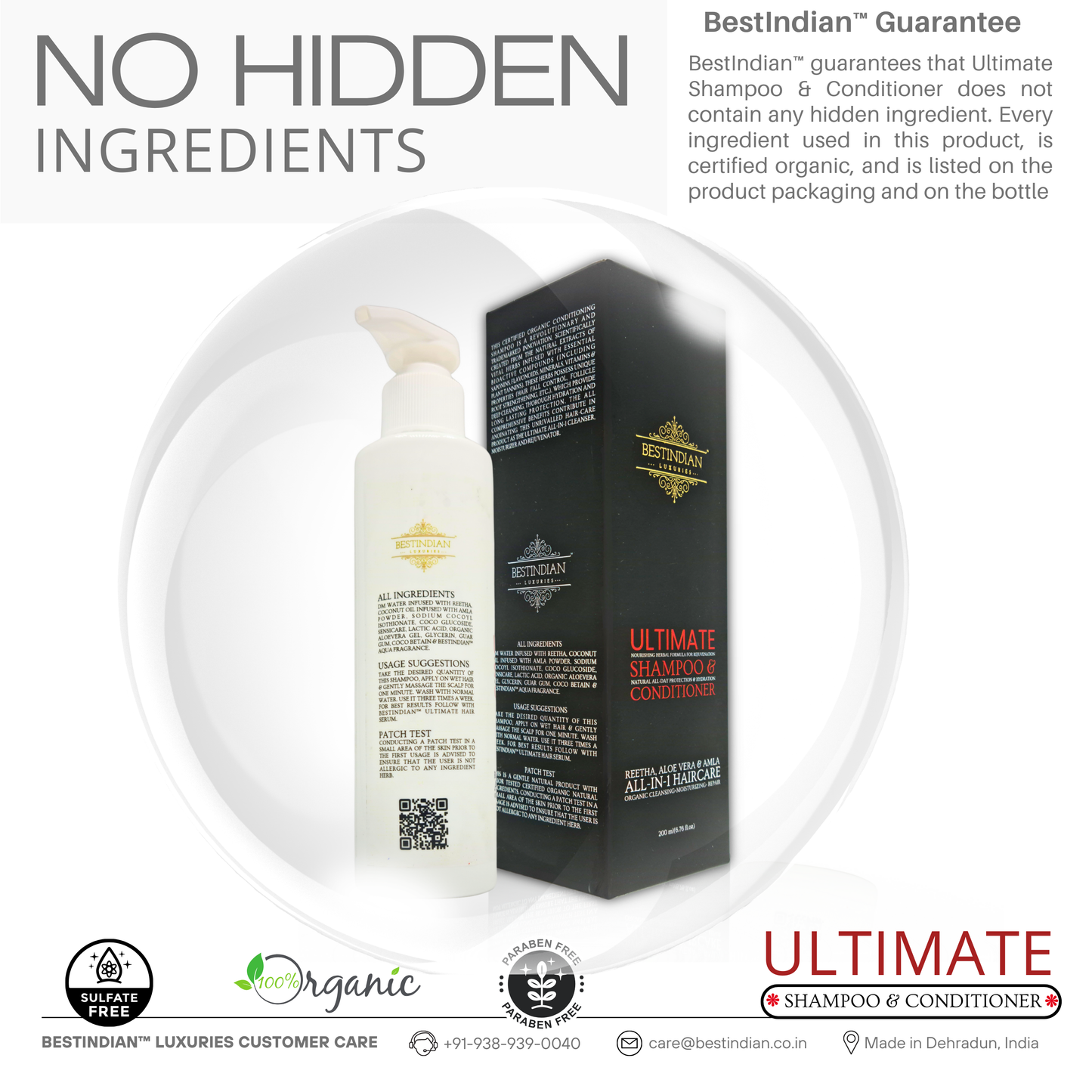
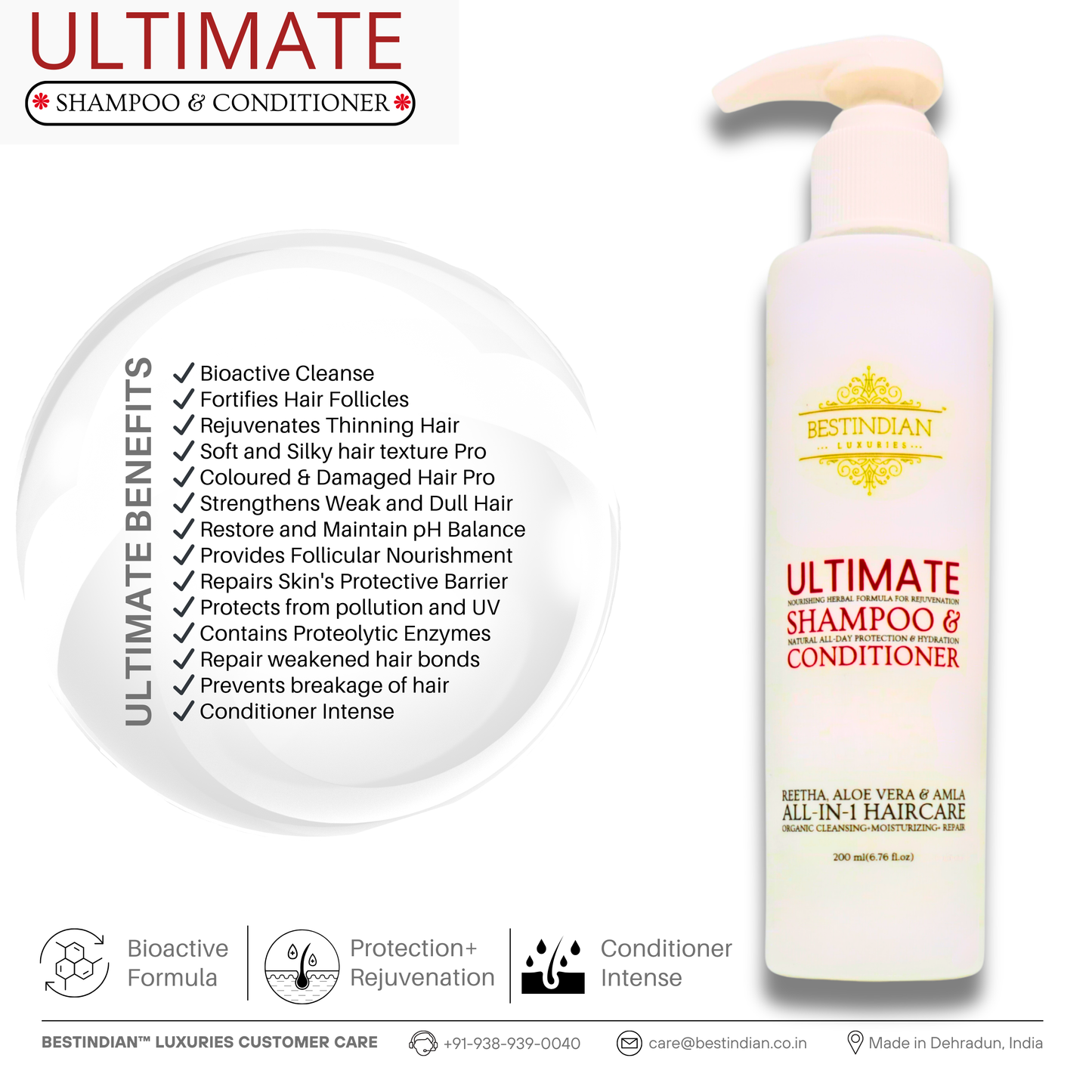
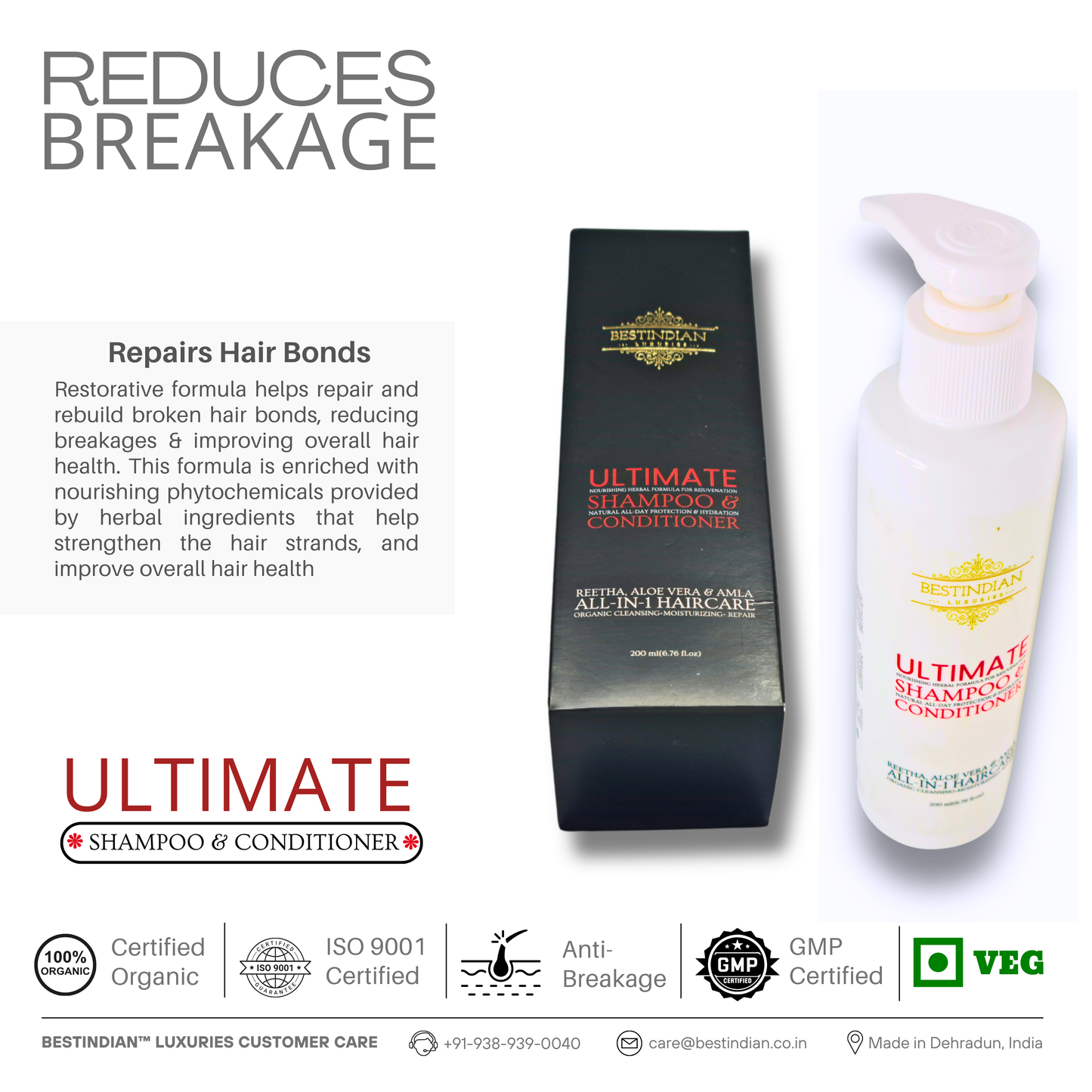
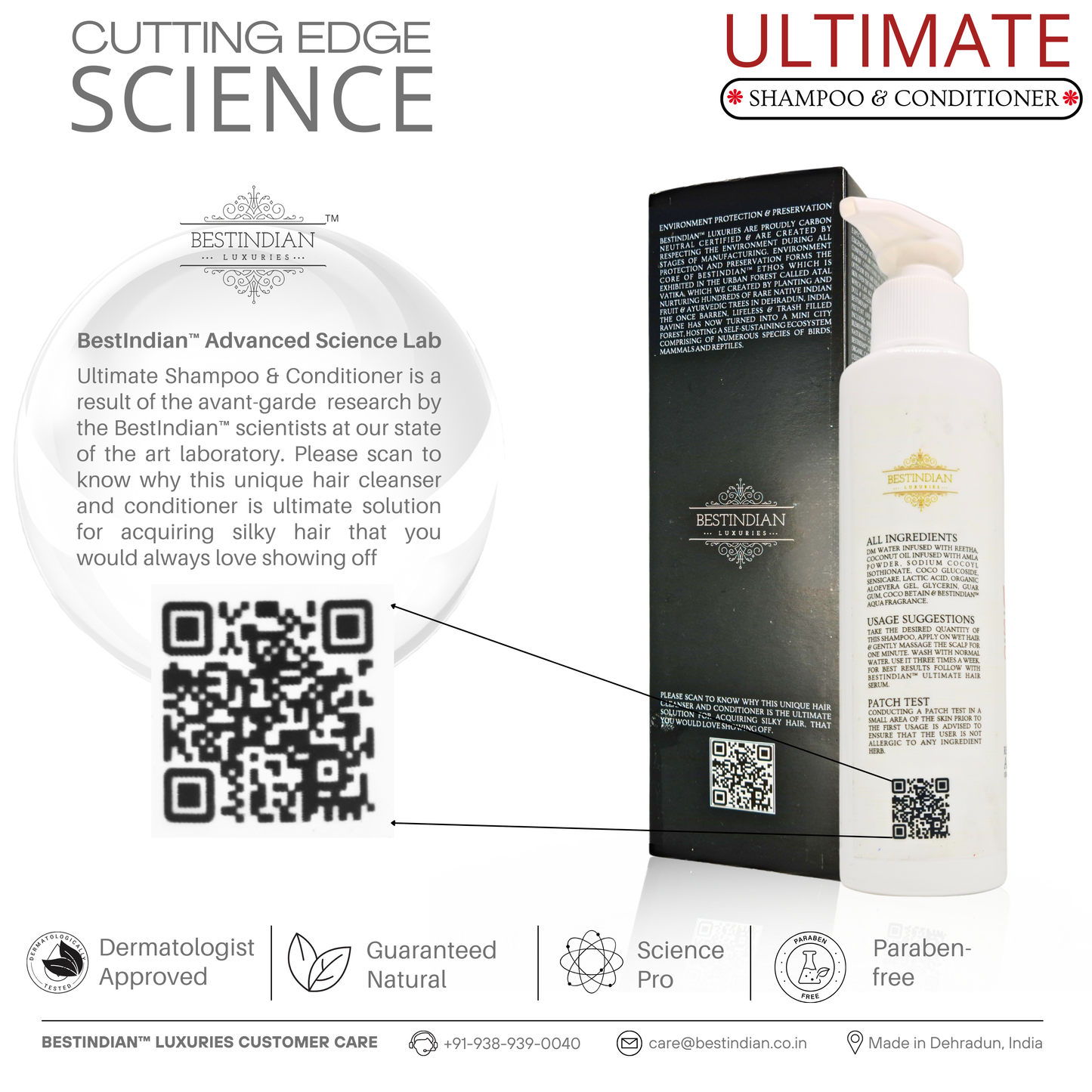

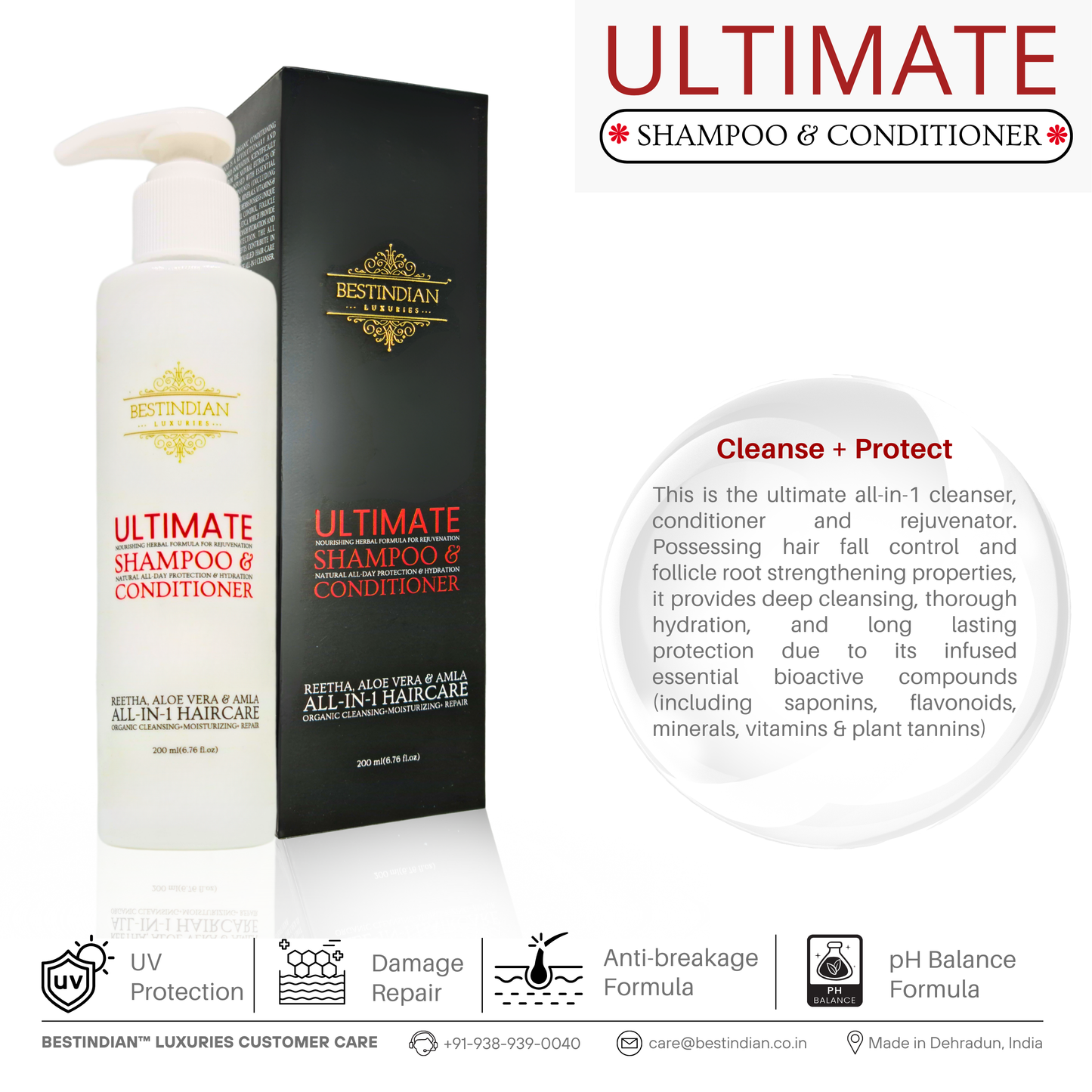
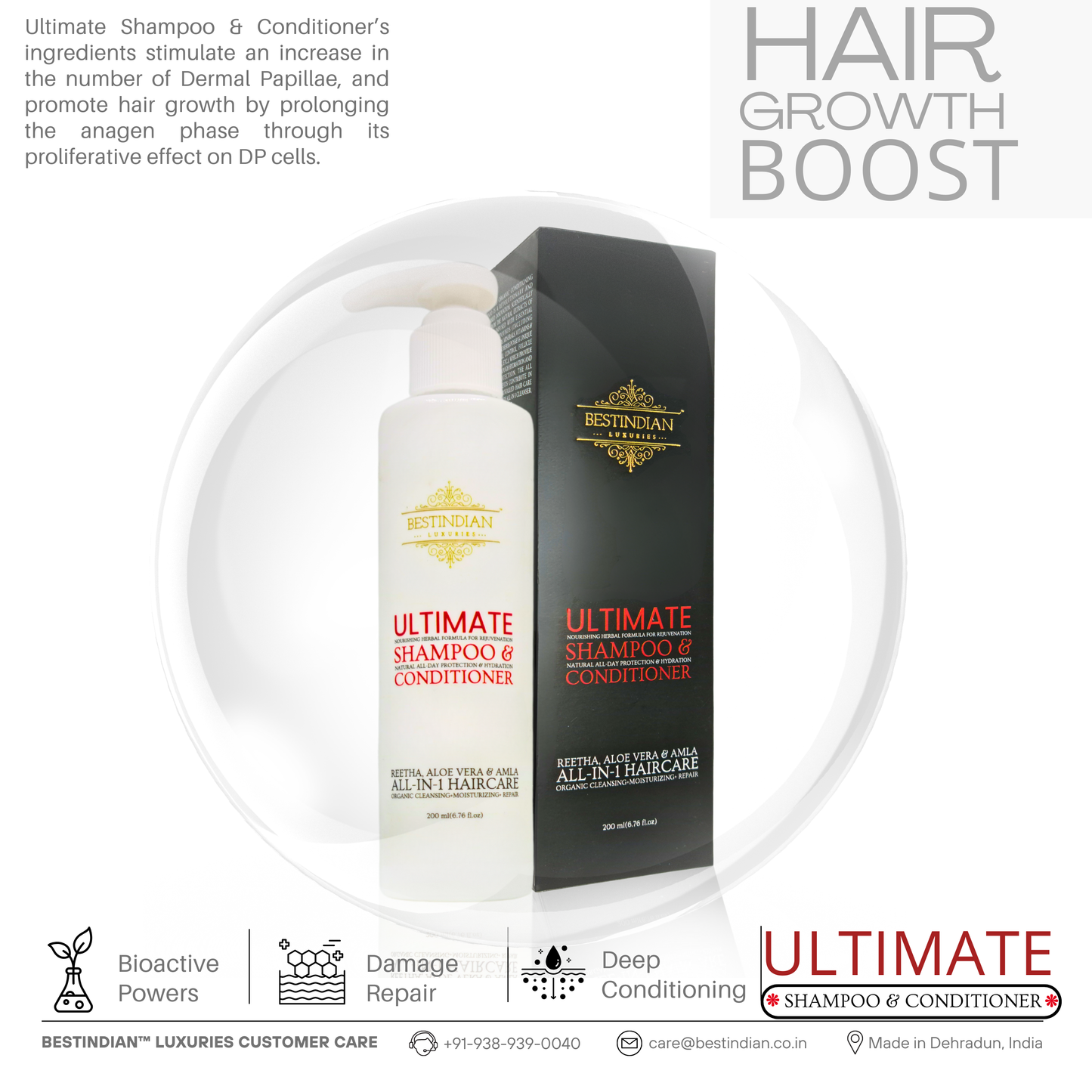
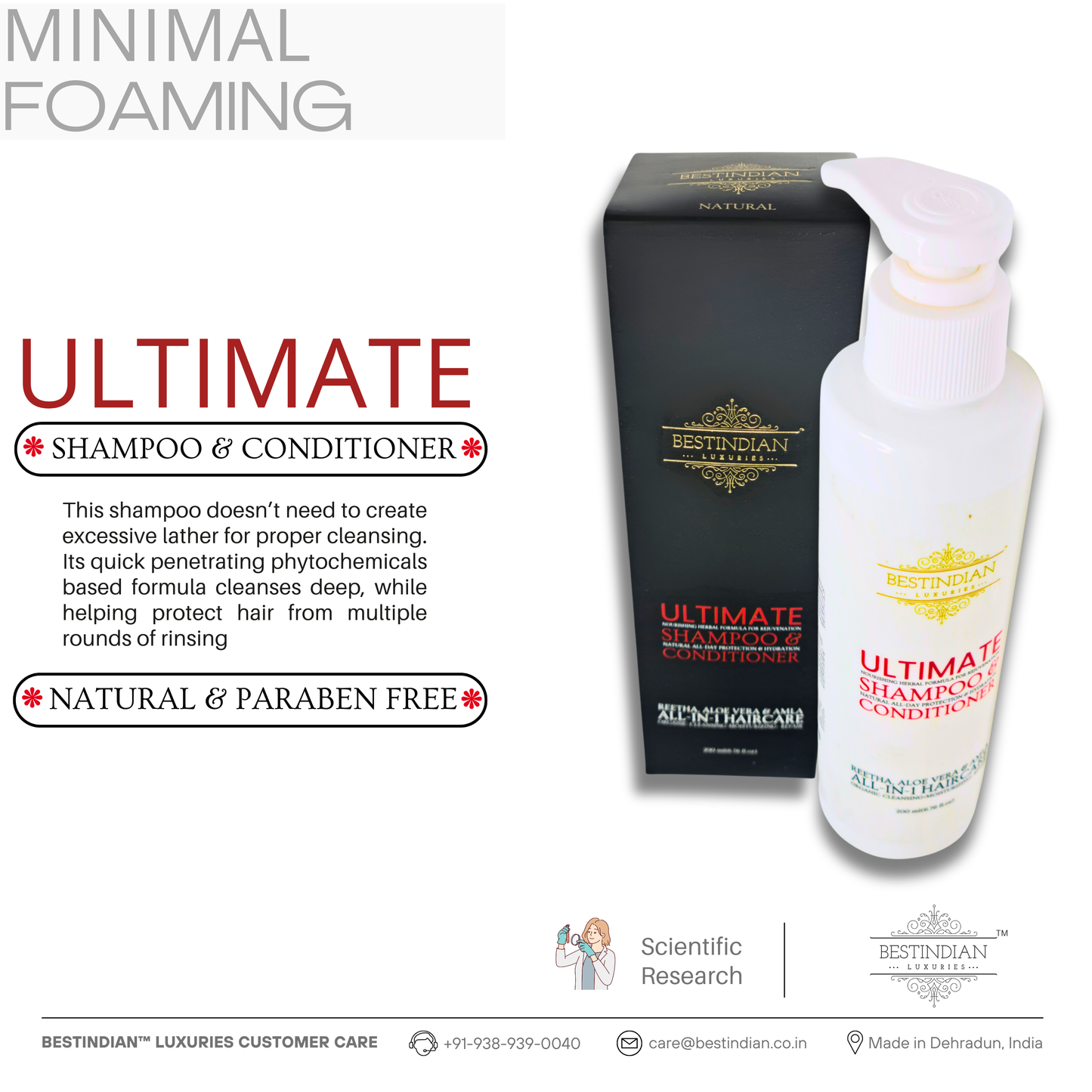
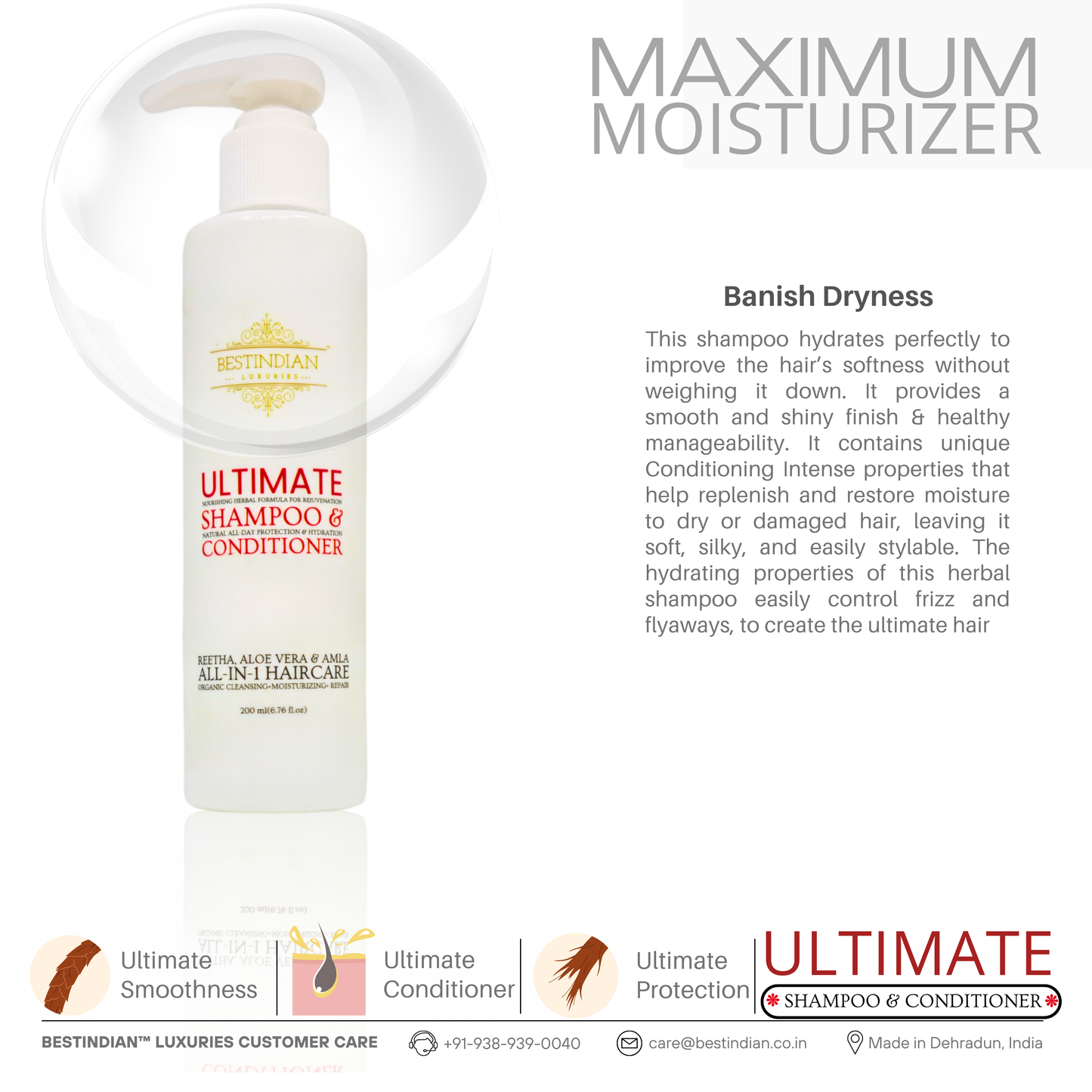
BESTINDIAN LUXURIES
The Finer Details
Why You’ll Love It
Struggling with dandruff, dryness, or hair fall? Discover BestIndian™ Ultimate Shampoo & Conditioner – a sulfate-free, pH-balanced formula crafted with Amla, Reetha & certified organic Aloe Vera. This gentle Ayurvedic blend helps strengthen roots, improve scalp comfort, and leave hair soft, smooth, and full of life.
A Hair Fall Control Shampoo That Strengthens Roots
⚜️ Experience a significant reduction in the appearance of hair fall from breakage. Our potent hair fall control shampoo is enriched with the Ayurvedic powerhouse Amla, which is abundant in Vitamin C and amino acids. It provides deep nourishment to the follicles, helping to fortify roots and make hair feel stronger and more resilient.
An Effective Anti Dandruff Shampoo for a Healthy Scalp
⚜️ Achieve a clean, calm, and comfortable scalp. This effective anti dandruff shampoo utilizes proteolytic enzymes and purifying botanicals to gently exfoliate dead skin cells and remove buildup. It helps to soothe the feeling of an itchy scalp and creates a perfectly balanced environment, free from flakes.
A Sulfate Free Shampoo for Gentle Cleansing
⚜️ Cleanse your hair without compromise. Our sulfate-free shampoo uses the natural power of Reetha to provide a deep, effective cleanse with a minimal, creamy lather. It removes impurities and excess oil without stripping your hair of its essential natural moisture, making it gentle enough for daily use.
The Best Ayurvedic Shampoo for Hair Growth
⚜️ Create the ideal foundation for healthy-looking growth. As one of the best Indian shampoo formulations rooted in Ayurveda, it purifies and nourishes the scalp with natural minerals and proteins from ingredients like Aloe Vera. This supports the natural hair growth cycle for hair that appears thicker and more vibrant.
A pH Balanced Shampoo for Sensitive Scalps & Color-Treated Hair
⚜️ Protect your scalp's health and your hair's vibrancy. This carefully formulated pH balanced shampoo is ideal for those with a shampoo for sensitive scalp. It respects your scalp's natural environment to prevent dryness and irritation. This gentle formula is also color-safe, helping to extend the life of your color by preventing fading.
All Benefits
This is more than a shampoo; it is a complete, all-in-one treatment for total hair and scalp wellness. Our formula is designed to work on multiple levels—purifying the scalp, strengthening the roots, and nourishing the strands—to deliver a visibly healthier, more resilient, and radiant head of hair.
⚜️ Scalp Health & Hair Fall Control
- Potent Hair Fall Control: As a leading hair fall control shampoo, it is enriched with nourishing ingredients that help strengthen hair strands from the root, significantly reducing breakage and the appearance of hair fall.
- Soothes & Balances the Scalp: This is an effective anti dandruff shampoo that also soothes the feeling of an itchy scalp. Its formula contains proteolytic enzymes that gently exfoliate and remove dead skin cells, helping to create a clean, balanced, and comfortable scalp environment.
- Nourishes Follicles: The ayurvedic shampoo formula purifies and nourishes the scalp with natural minerals and proteins, creating the optimal conditions to support the natural hair growth cycle.
⚜️ Cleansing & Purification
- Gentle, Sulfate-Free Cleansing: This sulfate free shampoo provides a thorough yet gentle cleanse. It effectively removes impurities, excess oil, and product build-up without stripping the hair of its essential natural oils, making it ideal for frequent use.
- Minimal Lather, Maximum Efficacy: Our advanced formula uses deep-penetrating phytochemicals for a maximum cleanse with minimal lather, which means less time spent rinsing and less mechanical stress on your hair.
⚜️ Strength, Repair & Growth
- Strengthens Brittle Hair: The formula is designed to improve the texture of brittle hair, helping to fortify each strand and make it feel stronger and more resilient.
- Supports Hair Repair: Its restorative formula helps to improve the strength and resilience of the hair fiber, which reduces breakage and improves the overall appearance of hair health.
- Promotes Healthy-Looking Growth: By creating an ideal scalp environment and nourishing the roots, this shampoo for hair growth supports a healthy, vibrant appearance as your hair grows.
⚜️ Hydration, Shine & Frizz Control
- Provides Weightless Hydration: The formula gently hydrates to help restore moisture and improve softness without weighing the hair down, for a smooth, silky, and shiny finish.
- Controls Frizz & Flyaways: The hydrating properties of this herbal shampoo help to smooth the hair cuticle, effectively controlling frizz and flyaways for a more manageable and polished look.
- Imparts a Beautiful Shine: It provides a beautiful, natural gloss to the hair, making it look glossy, vibrant, and healthy.
⚜️ Formula & Suitability
- pH Balanced for Scalp Harmony: Our carefully formulated pH balanced shampoo respects your scalp's natural acidic mantle, which is crucial for preventing dryness and maintaining overall hair health.
- Suitable for All Hair Types: This versatile formula is effective for all hair types, including damaged, colored, chemically treated, and heat-styled hair.
- Color Safe: It helps to extend the life of your hair color by gently cleansing without stripping, which helps to prevent color fading and maintain vibrancy.
This is a complete 2-in-1 hair fall control and anti-dandruff shampoo. Its natural, sulfate-free Ayurvedic formula strengthens roots, soothes the scalp, and provides weightless hydration for all hair types, including colored hair.
Your Ritual & Care
To unlock the full potential of this nourishing formula, we recommend adopting this professional hair care ritual. Following these steps will ensure a gentle yet thorough cleanse, maximize the absorption of beneficial botanicals, and leave your hair feeling soft, strong, and beautifully revitalized.
⚜️ Who It's For
This versatile, gentle yet deep cleansing shampoo is perfect for both women and men, and is suitable for all hair types, textures, and lengths. It is especially recommended if you:
- Are looking for a potent hair fall control shampoo or have thin, brittle hair that breaks easily.
- Need a deep cleansing yet gentle solution for issues like dandruff or an itchy, sensitive scalp.
- Have colored, highlighted, chemically treated, or frequently heat-styled hair and want to maintain vibrancy and health.
- Live in a polluted environment or are frequently exposed to sun, dust, or dry, air-conditioned air.
- Experience common concerns like dryness, dullness, frizz, flyaways, or tangles.
⚜️ The Step-by-Step Ritual
- Prepare: Gently brush or comb through dry hair to detangle before washing. Hair is at its most fragile when wet, so this pre-step helps to minimize breakage.
- Wet Thoroughly: Allow lukewarm water to flow over your hair for at least a minute, ensuring every strand is fully saturated. This helps to open the hair cuticles for better absorption of the conditioning phytochemicals.
- Cleanse & Massage: Take a coin-sized amount of the shampoo. Gently massage it into your scalp and roots for one minute, working up a minimal, creamy lather. Work the lather down to your mid-lengths and tips.
- Rinse Completely: Rinse your hair thoroughly with normal water, ensuring no residue is left. Avoid using very hot water as it can strip the hair and scalp of natural oils.
- Follow Up: For the best possible results, follow your cleanse with the BestIndian™ Ultimate Hair Serum.
⚜️ Frequency of Use
You can use this shampoo as often as required. Its gentle, sulfate-free shampoo formula is ideal and perfectly safe for daily use, as it cleanses effectively without harming the hair follicles or stripping beneficial natural oils.
⚜️ Care & Storage
- Storage: To protect the integrity of the natural ingredients, store in a cool and dry place, away from direct sunlight.
- Usage: This product is for external use only.
- Patch Test: We always recommend performing a patch test on a small area of the skin prior to first usage.
- Shelf Life: For optimal freshness and efficacy, use within 24 months of manufacturing.
Complete Your Hair Care Ritual
- ⚜️ Explore the Complete Natural & Ayurvedic Hair Care Collection
- ⚜️ Step 2: Follow with our Ultimate Hair Serum for frizz control and added shine
Experience the pinnacle of holistic hair care with BestIndian™ Ultimate Shampoo & Conditioner. If you're searching for the best Indian shampoo that combines nature's wisdom with scientific efficacy, your quest ends here.
Fragrance
The sensory experience of the Ultimate Shampoo & Conditioner is designed to transport you. The fragrance is a clean, refreshing, and sophisticated aquatic blend that elevates your daily hair wash into a moment of pure escape.
⚜️ The Olfactory Profile: An Exotic Aquatic Escape
- The Inspiration: The scent is inspired by the pristine sea shores of the exotic Lakshadweep islands.
- The Scent Experience: The unforgettable aquatic fragrance is clean, fresh, and ozonic. It evokes the feeling of a cool sea breeze, with hints of sea salt and lush coastal botanicals, leaving your hair with a subtle and beautifully fresh scent that lasts all day.
⚜️ The BestIndian™ Purity Promise
- A Sophisticated, Skin-Safe Aroma: The fragrance of this organic shampoo is our proprietary BestIndian™ aqua fragrance. It is expertly crafted to be free from harsh perfumes and phthalates, aligning with our commitment to pure, gentle, and effective formulas certified for organic integrity.
This shampoo features a refreshing and unforgettable aquatic fragrance inspired by the Lakshadweep islands. The skin-safe scent is clean and fresh, with hints of sea salt and coastal botanicals, aligning with the product's organic certification.
Ingredient Transparency
Trust & Transparency: The BestIndian™ Promise
At BestIndian™, we believe luxury is defined by authenticity and efficacy. Our philosophy marries the timeless wisdom of Ayurveda with the precision of modern science. We practice 100% ingredient transparency because your trust is our most valued asset.
Full Ingredient List (INCI)
Aqua (Water), Aloe Barbadensis (Aloe Vera) Leaf Juice, Coco-Glucoside, Cocamidopropyl Betaine, Sodium Cocoyl Isethionate, Glycerin, Sapindus Mukorossi (Reetha) Fruit Extract, Cocos Nucifera (Coconut) Oil, Emblica Officinalis (Amla) Fruit Powder, Cyamopsis Tetragonoloba (Guar) Gum, Phenoxyethanol, Ethylhexylglycerin, Lactic Acid, Fragrance (Parfum).
Ingredient Deep Dive
⚜️ Reetha (Sapindus Mukorossi): The Natural Cleanser
A revered Ayurvedic herb, Reetha is nature’s own shampoo. It is rich in natural cleansing agents called saponins, which effectively purify the scalp and hair by lifting away dirt and excess oil without the harshness of synthetic sulfates.
⚜️ Amla (Emblica Officinalis): The Root Strengthener
A cornerstone of any authentic amla shampoo, this superfruit is a powerhouse of Vitamin C and antioxidants. It provides deep nourishment to the hair follicles, which helps to strengthen the roots, reduce the appearance of breakage, and support a healthy hair growth cycle.
⚜️ Organic Aloe Vera (Aloe Barbadensis): The Scalp Soother
Known for its incredible soothing and hydrating properties, the organic Aloe Vera in our formula is essential for scalp health. Its bioactive compounds and enzymes help to calm the scalp, reduce the feeling of itchiness, and provide essential moisture to prevent dryness.
⚜️ Coconut-Derived Cleansers: The Gentle Foaming Agents
Instead of harsh sulfates, we use a blend of ultra-gentle, coconut-derived cleansers like Sodium Cocoyl Isethionate and Coco-Glucoside. These create a soft, creamy lather that provides a thorough cleanse without stripping your hair's natural, protective oils.
⚜️ Lactic Acid: The pH Balancer
A key component of our scientifically balanced formula, Lactic Acid is a gentle Alpha-Hydroxy Acid (AHA). We use it to carefully adjust the shampoo's pH to match the natural acidity of your scalp, which is crucial for preventing dryness, frizz, and maintaining a healthy scalp environment.
Formulated Without
Our commitment to purity means you will never find these in our Ultimate Shampoo & Conditioner:
- Sulfates (SLS/SLES)
- Parabens
- Phthalates
- Silicones
- Harsh Synthetic Dyes
- Mineral Oil
Our transparent, sulfate-free formula features Ayurvedic Reetha for natural cleansing, Amla for strengthening roots, and organic Aloe Vera for soothing the scalp. This shampoo is free from parabens and silicones, disclosing all ingredients for your peace of mind.
Frequently Asked Questions
1. What makes BestIndian™ Ultimate Shampoo different?
Unlike many single-focus shampoos, this is a 2-in-1 conditioning shampoo. It combines revered Ayurvedic botanicals like Amla and Reetha with modern bioactive science, ensuring deep cleansing, scalp comfort, and lasting smoothness—all in one step.
2. Why doesn't this shampoo create a big lather? Is it still cleaning?
Yes, it provides a deep, effective cleanse. As a sulfate-free shampoo, it uses natural saponins from Reetha which create a gentle, creamy lather instead of the big bubbles made by harsh chemical detergents. This is a sign that it's cleaning thoroughly without stripping your scalp's natural oils.
3. Is sulfate-free shampoo better than regular shampoo?
Sulfate-free shampoos like ours cleanse effectively without harsh detergents. They help preserve your scalp's natural moisture, reduce the feeling of dryness, and make hair feel smoother—which is especially beneficial if you have a sensitive scalp, frizz-prone, or color-treated hair.
4. Do I still need a separate conditioner?
For most hair types (normal, oily, fine), its rich, nourishing formula provides enough conditioning to leave hair soft and manageable. For those with extremely dry or coarse hair, you may still benefit from following up with our Ultimate Hair Serum for extra hydration.
5. Is this product vegan and cruelty-free?
Yes. All BestIndian™ products, including the Ultimate Shampoo & Conditioner, are 100% vegetarian, vegan-friendly, and are never tested on animals. Our manufacturing facility is certified cruelty-free.
6. How much shampoo should I use each wash?
A coin-sized amount is enough for most hair lengths. Work it into a minimal, creamy lather on the scalp and rinse thoroughly. For longer or very thick hair, you may repeat with a second small application if needed.
7. What fragrance does this shampoo have?
The fragrance is inspired by the pristine sea shores of the Lakshadweep islands — a fresh, aquatic, and refreshing aroma that makes every wash a rejuvenating sensory experience.
8. Which is the best Ayurvedic shampoo for dandruff in India?
BestIndian™ Ultimate Shampoo & Conditioner is one of the best Ayurvedic options. It’s a sulfate-free shampoo made with Amla, Reetha & Aloe Vera to help reduce the visible signs of dandruff and improve scalp comfort.
9. What is the best shampoo for hair fall control and growth?
For a hair fall control shampoo, choose one that strengthens roots and supports scalp health. BestIndian™ Ultimate uses Amla and Aloe Vera to improve the look of thinning hair and encourage a healthy-looking growth environment.
10. Can I use a sulfate-free shampoo every day?
Yes. Gentle, sulfate-free shampoos like BestIndian™ Ultimate are pH balanced, making them safe for daily use without drying out your scalp or hair.
11. Which shampoo is best for dry and frizzy hair?
A hydrating, conditioning shampoo is best. BestIndian™ Ultimate combines Aloe Vera and natural conditioners in a sulfate-free shampoo to smooth frizz, tame flyaways, and leave hair feeling soft.
12. Is this shampoo safe for colored hair?
Yes. BestIndian™ Ultimate is a color safe shampoo. Its gentle cleansing and conditioning formula helps maintain vibrancy and reduces the feeling of dryness in dyed or chemically treated hair.
13. What is a chemical-free shampoo?
A chemical-free shampoo avoids harsh sulfates (SLS/SLES), parabens, and unnecessary synthetic chemicals. BestIndian™ Ultimate is sulfate-free, paraben-free, and made with certified organic botanicals.
14. Which natural shampoo is good for a sensitive scalp?
BestIndian™ Ultimate Shampoo is an ideal shampoo for sensitive scalp. With soothing Aloe Vera and gentle coconut-derived cleansers, it cleans effectively without causing irritation.
This is one of the best Ayurvedic shampoos in India for hair fall and dandruff. Its sulfate-free, pH-balanced formula with Amla and Reetha is safe for daily use on all hair types, including sensitive and color-treated hair.
The Science & Sensory Experience
The Science & Sensory Experience
⚜️ This sulfate-free shampoo is scientifically engineered to work in harmony with your scalp's natural biology. Our advanced formula uses natural saponins from Reetha for a deep yet gentle cleanse that produces a minimal, creamy lather. This effective action is delivered in a carefully pH balanced shampoo that respects your scalp's delicate environment. The experience is completed by a refreshing aquatic fragrance, transforming your daily wash into a moment of pure, holistic care.
The efficacy of the BestIndian™ Ultimate Shampoo & Conditioner is not just traditional; it's a result of a deep understanding of hair biology and chemistry. Our formula is scientifically engineered to work in harmony with your hair and scalp's natural state, delivering superior results without harsh chemicals.
⚜️ The Science of Gentle, Sulfate-Free Cleansing
Your scalp naturally produces a protective, oily substance called sebum. While essential for lubricating and protecting your hair, excess sebum can attract dirt and build up. Harsh detergent shampoos, like those with sulfates (SLS/SLES), can strip away this entire protective layer, leaving the hair and scalp dry and irritated. Our formula takes a more intelligent approach. We use natural cleansing agents called saponins from the Ayurvedic herb Reetha. These gentle surfactants effectively emulsify and remove excess oil and particulate soil without over-stripping, leaving your scalp's natural balance intact.
⚜️ The Science of Natural Conditioning
When you wash your hair, the hair fiber gains a negative electrical charge. This negative charge causes individual strands to repel each other, which we perceive as frizz, static, and tangling. Our formula acts as a "smart" conditioner by using positively charged conditioning agents derived from our natural botanicals. These agents are electrostatically attracted to the negatively charged areas of your hair. This gentle bond does several things:
- It lubricates the surface of the hair cuticle, reducing the sensation of roughness and making hair easier to comb.
- It neutralizes the negative charge, which allows hair strands to align smoothly, significantly reducing clumping and frizz.
- It forms a light, protective layer that leaves hair feeling soft and looking glossy, without the heavy build-up associated with synthetic silicones.
⚜️ The Science of a Healthy Scalp (The Importance of pH)
The health of your hair begins with a healthy scalp. An alkaline pH (a pH above 7) can increase the negative electrical charge on the hair's surface, which lifts the cuticle scales and increases friction between fibers. This can lead to cuticle damage and breakage. Our pH balanced shampoo is carefully formulated to be mildly acidic, matching your hair and scalp's natural state. This is scientifically proven to cause less frizzing by keeping the hair cuticle sealed, smooth, and flat, which is the key to maximizing natural shine and strength.
This shampoo's science lies in its natural approach. Gentle saponins from Reetha cleanse without stripping sebum. Natural conditioning agents neutralize the hair's negative charge to reduce frizz. The formula is pH-balanced to keep the hair cuticle sealed for maximum shine and strength.
Star Ingredients
-

Reetha
⚜️ A renowned Ayurvedic herb, Reetha is nature's own gentle cleanser. It is rich in natural saponins that effectively purify the scalp and hair, lifting away dirt and excess oil without the harshness of synthetic sulfates. Reetha (Sapindus mukorossi) contains saponin, which has natural cleansing properties. It contains sapindosides (A, B, C, D), and mukorossi saponin (E1, Y1) such as diosin, proto diosgenin, gitoxigenin, chlorogenin, and ruscogenin. It is anti-inflammatory & antimicrobial.
-

Aloe Vera
⚜️Known for its incredible soothing and moisturizing properties, certified organic Aloe Vera is essential for scalp health. It delivers a wave of lightweight hydration to calm the scalp and prevent the feeling of dryness and itchiness. Aloe Vera soothes and nourishes the scalp and promotes hair growth, as it increases blood circulation to the scalp. The main bioactive compounds are vitamins A & C, aloin, barbaloin, β-barbaloin, and isobarbaloin. Other elements are aloe-emodin, emodin, resin, etc.
-

Amla
⚜️A true super-ingredient for hair, Amla is a powerhouse of Vitamin C and antioxidants. It provides deep nourishment to the follicles, helping to strengthen roots and reduce the appearance of breakage for visibly resilient hair. The fruit of Emblica officinalis, family Euphorbiaceae, is rich in vitamin C, minerals, and amino acids. It makes the roots stronger, promotes hair growth and is conducive for color retention. It is a powerful treatment for hair loss and baldness.
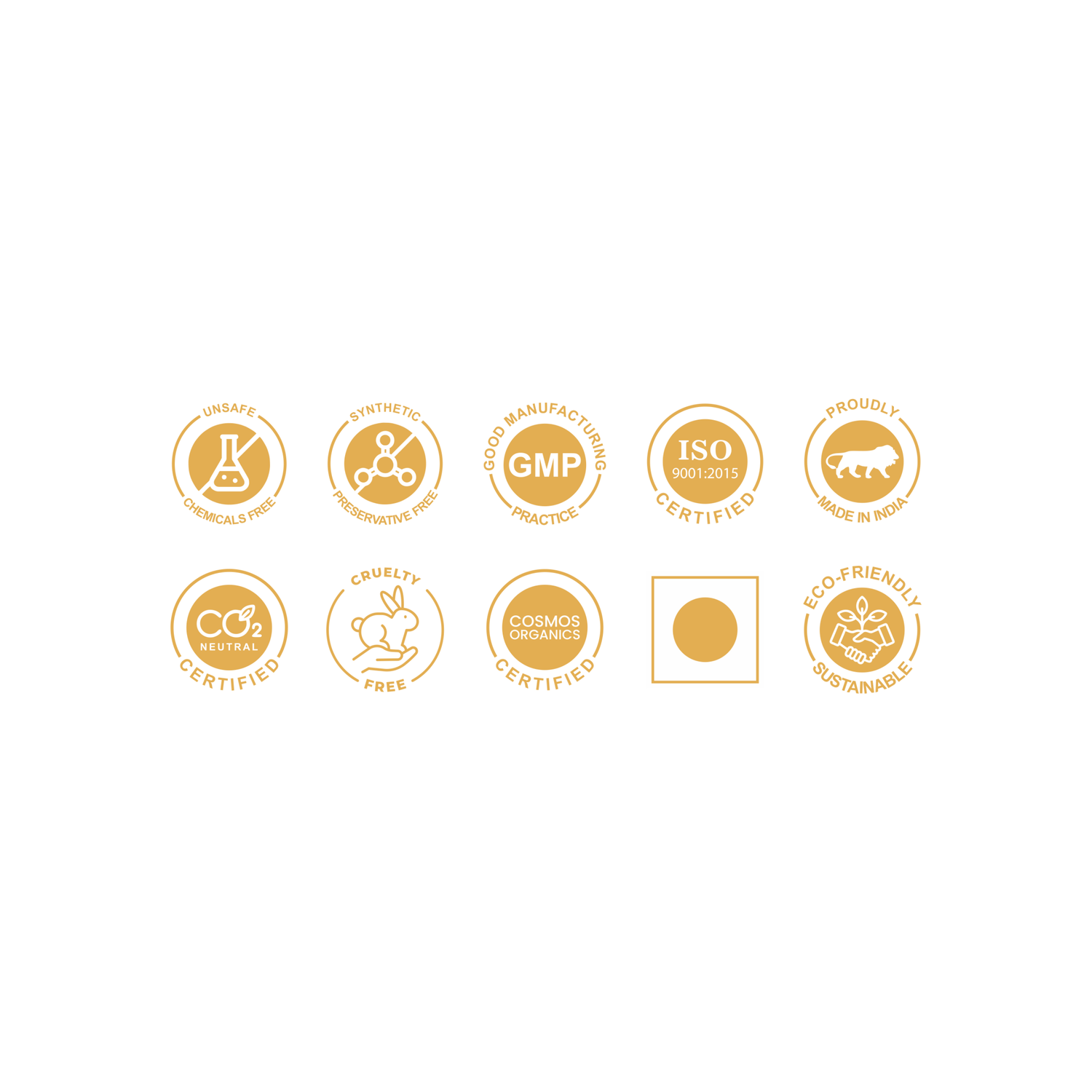
Trust & Transparency
The BestIndian™ Promise
At BestIndian™, we believe luxury is defined by authenticity & efficacy. Our philosophy marries the timeless wisdom of Ayurveda with the precision of modern science. We disclose all ingredients used in every product we make, because your trust is our most valued asset.
⚜️
Our Promise: Formulated with 100% natural and certified organic ingredients. Always free from preservatives, parabens, and sulfates. Vegetarian and vegan friendly. No hidden ingredients.
⚜️
Our Certifications: Manufactured in a GMP, ISO & COSMOS Organic certified, carbon-neutral, cruelty-free facility amidst pollution-free environment of the Himalayas in Dehradun, India
OUR BRANDS
-
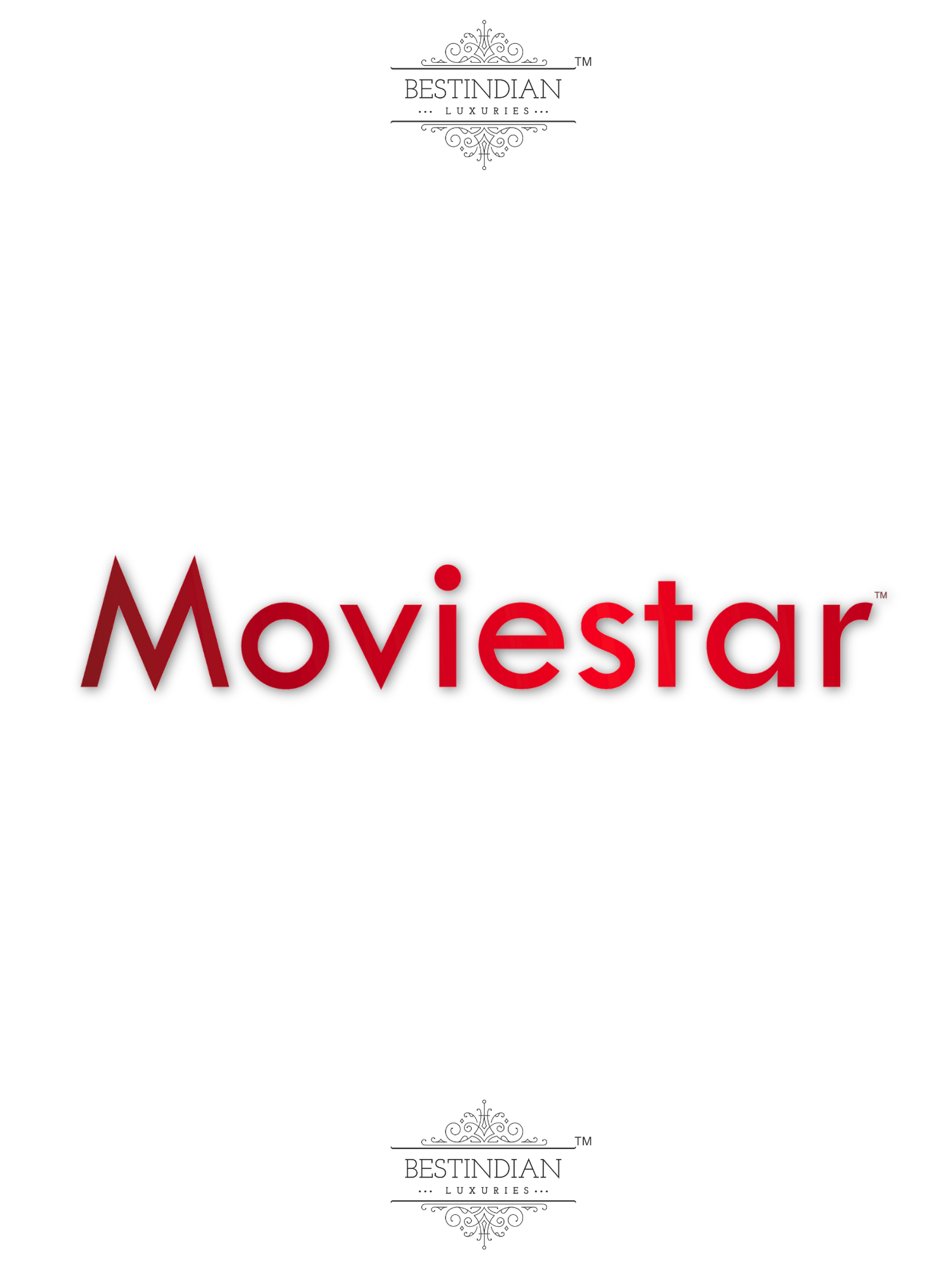
Moviestar™ – Luxury Ayurvedic Skincare brand by BestIndian™
Luxury skincare designed for professional actors. Moviestar™ by BestIndian™ is a premium...
-

GlowPotion™ – Natural Ayurvedic Skincare brand by BestIndian™
The pinnacle of beauty is a complexion that requires no makeup to...
-

The Elixir of Youth™ Collection for Anti-Aging & Wrinkle Repair
Welcome to Elixir of Youth™- scientifically created, high-performance Ayurvedic formulations designed by...



